
2017 AUGUST CLASSIC SAILBOAT OF THE MONTH – TILLY
Sail Number: GER 32
Type: Sonder Class (extreme fin keel “skimming dish”)
LOA: 39’4″ / 12m
LWL: 19’0″ / 5.80m
Beam: 7’2″ / 2.20m
Draft: 5’1″ / 1.55m
Designer: Wilhelm von Hacht
Original Owner: Mr. Richard Krogmann, Hamburg German and Royal Highness Prinz Heinrich von Preussen, brother of Wilhelm II.
Current Owner: Siegfried Rittler (1993)
Yacht Club: Deutscher Touring Yacht Club, Tutzing, Bayern
Year Launched: 1912
Built By: Geesthacht Hamburg, Germany
Hull Material: Wood (bright)
Gross Displacement: 1830 kg
Sail Aria: 51 sq m
Sail Number: GER 32
Tilly XV: Tilly XV 100 Year History
Historical:
Master Skipper Joerg Moessnang (1992 – present) – “Tilly XV was built 1912 for Mr. Richard Krogmann Hamburg German Reeder and his Royal Highness Prinz Heinrich von Preussen, brother of Wilhelm II., Tilly was designed by Willi von Hacht which was at this time a very famous naval engineer and owner of Willi von Hacht shipyard in Hamburg on the lake Alster. Tilly XV won the in this year the Kieler Woche hin his class and was directly sold to the President of the Bayerischer Yacht Club / Starnberger See Hauptmann Richard von Alweyer. After many owner changes Siegfried Rittler from Starnberg bought the yacht from Mr. Delle Karth Innsbruck/Austria under his command Tilly was sailing on Lake Garda / Italy. Tilly XV did won most of her races which she took part. In 2015 she won the Regattes Royales in Cannes her groupe and overal as best performance yacht. In 2016 she won the US Northamerican Panerai Classic Yacht Challange in the day racer class. Tilly XV is original as 1912.”
Class History:
The Sonder Class laid the foundations for German yachting, and had strict rules that allowed only three non-professional crew and women were not admitted as Mitseglerinnen at this time. The design was based on the American model (Scow), which must have taken at least some getting used to for die German sailors
( Originally Published 1911 )
The Sonder, or Special Class, as it is called, is for many reasons the most remarkable small racing class that we have, as, for the four years of its existence in this country, the critics, experts, and naval architects are still at a loss to decide upon the correct combination of measurements, weights, etc., that would go to make up the boat to win in all conditions of wind and water. In fact, from my own experience in the twelve boats I have designed, I believe it impossible to embody in one boat all the points that would make her successful under all conditions. It would take at least two, and possibly three, boats of entirely different design to cover every condition. This being the case, it is necessary to build the boat to sail in the conditions of wind and water that prevail in that country where she is to be used. A good example of this is the fact that the German trio, in 1906, built for conditions that prevail at Kiel, Germany, met with defeat at the hands of the American boats off Marblehead. And in turn, in 1907, the American trio that went to Germany, being large flat boats with little ballast, lost to the German team of narrow, heavily ballasted boats, under extremely severe weather conditions off Kiel. I will go into particulars as regards these con-tests later on in this Chapter as I had the pleasure of sailing on one of the American boats in both series.
The class originated in Germany, the restrictions being drawn up there, and a great number of boats have been built, for, to begin with, there was a cost limit of only $1224, which now has been raised to $1440 in Germany and to $2400 in the United States. This allowed even the men of small means to own and sail a racing craft, and in order to hold and increase the interest the Emperor of Germany offered valuable prizes to be sailed for each year during Kiel Week, and as many as twenty-five boats sometimes competed for them.
The first boat built in America was the “Uncle Sam,” in 1902. She was shipped to Kiel where she succeeded in winning the Emperor’s Gold Cup, after which she was purchased by his Majesty and given over to the Navy for the purpose of educating various officers in the handling of this small racing type. This boat is still in existence, which speaks well for the restrictions under which she was constructed.
In the summer of 1906 an arrangement was made between the Kaiserlicher Yacht Club of Kiel, Germany, and the Eastern Yacht Club of Marblehead, Massachusetts, for a series of races for the Roosevelt Cup, given by the Eastern Yacht Club, to be sailed off Marblehead in September. The teams were made up of three boats on a side — the first one winning three first places to take the Cup, and this series, is what gave the Class such impetus in this country.
There were seventeen boats built to compete in the trial races — the designs varying all the way from the wide flat scow to the narrow sharp-ended hull, with heavy lead. The general restrictions were that the length on the water-line, plus the greatest beam plus the greatest draft, should not be more than thirty-two feet. Also that the boat should not weigh less than 4035 pounds with equipment aboard, and that the sail area rated should not be more than 550 square feet in the main-sail and jib. The table of restrictions follows :
MEASUREMENT
L plus B plus D must not exceed 32 feet (9.75 meters).
L equals length on water-line B ” extreme beam D ” ” draft
With complete outfit on board ready for racing, but without crew. There will be no time allowance.
DISPLACEMENT
Displacement must not be less than 4035 pounds (1830 kilograms), without crew.
All yachts must be weighed.
COST OF CONSTRUCTION
The total cost of construction of the American yachts, including two suits of sails, must not exceed ten thousand marks ($2400).
CONSTRUCTION
The hull must be built of cedar, mahogany, or heavier wood, copper fastened (this term includes brass or composition bolts and screws).
Double planking not allowed.
The deck may be pine or any other wood. Deck and planking must not be less than t inches (16 millimeters) thick, no diagonal or ribband-carvel planking nor composite building and no centerboards or leeboards allowed. The cockpit must not exceed 8 feet (2.44 meters in length). The restriction on composite building does not prevent the use of a metal plate for a fin or of metals for interior trussing and bracing.
RIG
Rig optional. No hollow or built up or bamboo spars allowed. Sail area must not exceed 550 square feet (51 square meters), measured according to the rules of the International Yacht Racing Union. Yachts must carry at least one entire outfit of spars and at least one complete suit of sails on board during each race.
CERTIFICATE
Every yacht must produce an official measurer’s certificate stating that she has been built in accordance with the above conditions, a fact which shall be ascertained by the race committee before the beginning of the races.
CREW
The crew must be made up of amateur members of the yacht clubs which are admitted to the trial races and shall consist of not more than three persons, who must be citizens of the country in which the yacht was built.
CONDITIONS GOVERNING THE RACES
The races will be sailed according to the rules of the International Yacht Racing Union, under the joint control of the Kaiserlicher Yacht Club and the Eastern Yacht Club.
These restrictions mean that a boat could be any length over-all, and that you could use any combination of water-line, beam, and draft, so that naturally a wide difference of dimensions and weights resulted. One of the boats that year weighed over 5000 pounds and others were down to the given 4035. One, as per plans No. 38, was of the long exaggerated overhang, narrow beam, hard bilged, flat shoal scow, and this boat was chosen to be one of the American Defenders. Another, of the same general type, only wider and deeper, with less bilge angle, and smoother lined, proved easily to be the fastest of the fleet in light, smooth weather; mainly, I think, on account of her very light ballast and wonderfully prepared surface. Her condition was as nearly perfect as it is possible to get, having a mahogany skin, highly polished by trained piano polishers. She was also chosen, and the lines are shown under plans No. 37.
The third boat on the team, and which eventually won the Roosevelt Cup, was of an entirely different type, being narrow with sharp ends, heavy displacement, and a comparatively large quantity of ballast—about 2500 pounds, as compared with 1700 on the scows.
This did not, however, deter the believers in the scow type from continuing to build them, for in 1907 two scows were chosen, with one sharp-ended boat, to go to Germany to represent America. In the races at Kiel, which took place that summer, severe conditions of wind and water were met with, and the German boats, with their low sails, small narrow hulls, and very heavy lead, or ballast, were easily victorious. The only American boat to make any showing was the one with the smallest hull and sharp ends. And here I might add that the sails were very much against the success of the Americans, as they were too full for such severe conditions. The German boats having flat sails had a tremendous advantage, as the wind attained a velocity of forty miles an hour during some of the heavy squalls. The full sails of the American boats were all aback, while the flat sails of the Germans were carried full most of the time.
Another surprising point was that on a broad reach in the heavy sea, the narrow, sharp boats carrying full sail were forced through the water at a greater speed than the scows with single reefs, which was all they could carry. Under a less weight of wind pressure the scow would outreach the smaller boat.
On leaving Germany my mind was made up that the little hull with plenty of lead was the type to win with in the Sonder Class, and I have not changed my mind to any great extent since, as far as Kiel conditions go, unless it be in favor of the big scow, weighing 4800 pounds, with 2600 pounds of lead. This type has not been thoroughly tried out, al-though she is considered by many to be the correct idea. She would, however, be absolutely useless in other than very heavy conditions, and so it would be a difficult matter to get her selected during trial races, especially at Marblehead. In 1908 only one powerful boat was built in this country, the plans being shown in design 41.
She was very narrow, heavy displacement, excessive draft, and she proved to be the best of the American boats during that summer in a strong breeze and sea, going to windward in a remarkable manner, but slow reaching and running before the wind.
On the other hand, in 1908, the races showed the sharp-ended boats to be of little value in conditions at Marblehead, as the only boats to win in the Class were two extreme scows with light ballast and the boat last mentioned. The winner of 1906 and her sister boat did not get a first place.
The outcome of the 1908 races again set yachtsmen thinking as to what really was the correct type, and as yet this question has not been answered. The tendency, however, is to the broad flat boat for the 1909 trial races.
Designs 46 and 51 show the modified wide scow with reverse overhangs and low ends ; also the refined narrow scow with less reverse ; generally a compromise in an attempt to get a good average boat. These boats are being built for the 1909 races.
Having, in a general way, covered the German and American types I shall say a few words about the Spanish Class that again puzzles the minds of the various designers.
The American team of the year 1907, after leaving Germany, went to Bilbao and San Sebastian, Spain, for a series of races with the Spanish boats. The outcome of this series was a victory for Spain and the winner was an exceedingly narrow, sharp-ended boat with a heavy dead rise on the sections. The races at San Sebastian were drifting matches with an old ground swell rolling in from the Bay of Biscay. As I mentioned earlier in this book the sharp boats easily outdrifted the flat ones, especially in a rolling sea, again showing that the narrow, sharp-section boats were better in a slight roll, with no wind, although apparently fluky winds had something to do with the races being very unsatisfactory as a test of speed.
The following plan shows a sharp boat with a round, easy form, a boat that should be well adapted to foreign conditions, either in a light or heavy wind. (See design No. 42.)
Now, having given in a general way what this Sonder Class has actually done, I will say something as regards the makeup of the different types, the American boats having shown a great diversity in design.
From a first glance at the Sonder Class requirements, it would seem that the boat should be rigged as a cat boat, because the sail rating is the actual sail area of the main-sail plus the area of the fore triangle. This fore triangle has for a base line the intersection of the headstay with the deck and the fore side of the mast; and for a perpendicular, the intersection of the jib luff and the mast, or actually the highest jib halliard or spinnaker block. These areas added together must not be more than 550 square feet of area. This means that there will be a certain amount of area lost in the actual jib, as it would be impossible to completely fill the fore triangle with the jib. So it works out that there are actually about 525 square feet in the working sails, if the boat is rigged with mainsail and jib. This being so, I decided to try cat rigs on my boats in 1906, and planned the hulls accordingly.
Two of the boats that year were worked out under that rig with a great deal of care, but in the end were adjudged failures and their rig changed to jib and mainsails. One reason for this was that it was necessary to have the mast stepped well out on the forward over-hang, thus making it very difficult to hold the mast in place. Another reason was that the weight of the mast gaff, etc., being well for-ward, spoiled a sensitive hull and would not allow of free action, that is, the rise and fall of the hull in a seaway, which killed her life. The boats instantly showed more speed on being shifted back to the other rig, and one of them was later the first choice on the American team. The other steadily improved, until in the summer of 1908, with a somewhat different balanced rig, she proved to be by far the fastest boat of the fleet in light weather. The lines are shown below (number 40), and her dimensions are 38 feet over-all ; 19 feet 3 inches water-line; 5 feet 5 inches draft; and 7 feet 4 inches beam, with very low flat ends and weighing 4090 pounds. I am pleased to say that she was sailed by the youngest amateur in the fleet, he having had but three years’ experience and he sailed against some of the best amateurs in the country.
The boat that proved to be the best all-round boat in 1906 was a moderate formed, round, easy-lined, healthy type of little racer of the following dimensions : 35 feet 6 inches over-all, 19 feet 9 inches water-line, 6 feet 8 inches beam, 5 feet draft.
With a low rig and heavy ballast the entire craft weighed about 4500 pounds, and depending on her lead for her stability she was a good all-round boat. She used very flat English cut sails, setting to a nicety, and her painted hull was beautifully smoothed.
In 1907 there were comparatively few boats in the Trial Races for the selection of the team to go to Germany, and a sister boat of the ” Champion ” in 1906 was badly defeated. Two light weather scows and a 1906 boat were finally selected, none of which were first class in any way, though the best obtainable at the time.
In 1908 one new boat was built on the following plans : Her dimensions were 35 feet over-all ; 19 feet 3 inches water-line ; 6 feet 10 inches beam ; and 5 feet 10 inches draft, an excessive draft for these little boats, as proved by the season’s racing, the deep fin seeming to be a drag in any conditions, excepting a heavy blow to windward when she seemed at home. Under these conditions nothing could beat her, as she would hold on and go up across any bow in the fleet with apparently little effort, but she was slow across wind, or before it. She had a long, easy bow, especially adapted for a seaway, and her weight of 4450 pounds made her powerful, and although the center of gravity of the ballast was high up the combination was good for a breeze. (See design 41 a.)
Another boat in the 1908 fleet was the crack of 1906, but either the other boats had improved or she was not in as good condition, for she was usually beaten by from one to three boats in the races which she entered. And so again the balance of favor for the new boats of 1909 was toward the developed scow form, less brutal perhaps than the old scows, but of the scow type. Designs 46 and 51 for 1909 show the modifications :
Most of the American boats are equipped with fairly full sails — that is, sails with considerable draft or flow in them, as these seem to give the best results in our ordinary mid-summer conditions. In the early spring and fall, however, hard flat sails are essential, as was proven last year (1908), when one of the large scows, that had won practically nothing up to that time, came out with a flat suit and easily defeated the fleet in three heavy blows, winning thereby the Quincy Challenge Cup, raced for now by the Sonder Class. This win was accomplished mainly by the fact that she was able to point very high and still hold her headway, even though the hull was not especially good under the conditions. It is fair to add that the boat was almost perfectly handled by one of the finest amateurs in the country.
The balance of these boats is almost as necessary as a good hull and helmsman, as they balance on a narrow fin, are long over-all, with the rig well inboard, and turn in a very short radius. Of course, in light weather the helm will be carried amidships, or possibly a little lee helm is felt in very light drifts, but the minute the boat feels any wind pressure the helm should be in the center line, or slightly to weather. Then when it blows hard, the balance in a measure should remain about the same, anyway to windward.
It is in reaching that the boat will gripe, then being very hard on her helm, and to offset this trouble, trim the jib more or less flat and ease off the mainsail slightly and she will at once show better speed.
The rig on several of the boats, such as halliards, main, and preventer backstays, lead below deck, thus offering less windage and making things more trim and snug. This, however, is carrying things pretty far unless the owner or skipper understands this sort of rigging pretty thoroughly. Wire rigging is quite generally used and all the halliards have tackles so that the sails may be set up during a race if necessary. In most of the boats the cockpit is amidships, thus bringing the crew over the center of buoyancy where they should be allowed to sit well down in the bottom, as practically none of the boats now use water-tight cockpits, some going so far as to leave out bottom boards or slats entirely, the crew sitting or standing, as the case may be, directly on the inside of the planks and floors. This is done to save weight, as the bottom of the fin is the place for all ballast in these racing machines.
As regards structural strains, etc., I have found the best method, and in fact the only one to stand the strain of three years’ racing, to be three sets of longitudinal trusses placed between deck and bottom, this only applying to the extreme flat-ended scow, as she is necessarily hard on herself in a seaway, and if the ends drop any the boat will go badly over length. She is only one foot and a few inches from deck to bottom for the greater part of her hull ; has 2000 or more pounds of lead hung in the middle ; and with the low flat ends the pounding in a seaway is very severe, so it is necessary to thoroughly brace her. Plank on edge trusses, with lattice work and uprights, tie rods, etc., are very essential for this form, and it has always seemed to me to be the most satisfactory bracing, as well as the lightest. These trusses are shown on the construction plans very clearly.
I think that the best combination of rig is about 425 square feet in the mainsail and 100 square feet in the jib ; this, with the short base to the fore triangle allows of a good height for the spinnaker block, which greatly benefits the effectiveness of the spinnaker, as was proven by one of the boats in 1908, when her change in rig put her from a medium good boat to the best in the class, to my mind. This was due almost entirely to the raising of the spinnaker block clear of the mainsail, so giving the spinnaker head a chance to do good execution. It was not bothered in any way by the mainsail, so I have adopted this plan for the six boats I have designed for the summer of 1909.
I looked over the German boats very care-fully in 1907 and they certainly have a great advantage in construction over anything that I have yet seen built in this country. The Spanish cedar used by them has been drying out for years and many of them were built with flush seams, having no calking whatsoever. This insured a good surface under any conditions, as there was no putty to squeeze out; also, instead of using rivets with bungs, of which there are about 4000 in one of our boats, they use small brass or copper nails, small headed, and flush with the outer surface. The skin was varnished above the water; with paint or potlead below the surface, and was polished to a high point of perfection. Their planking is very light, and on account of the small sharp-ended hulls they require very little interior bracing. These facts allow them to carry a very large percent-age of lead to total weight, about 60 per cent, which means about 2600 pounds of ballast — a very great advantage. They were also fairly heavy ; weighing 4300 to 4600 pounds — another advantage in their weather conditions, and so they were able to lug their rigs far longer than the American boats.
Their dimensions were very moderate — about 33 to 36 over-all, 4 feet 8 inches draft and 6 feet 6 inches beam, allowing thereby a long water-line of about 21 feet. They had very easy formed high ends, the angle of rise being twice as much as that of the Americans. There were no reverse curves in the profiles, but the overhangs ran straight from the middle body. Their sections were very round, with a heavy dead rise, and forward the sections worked into a “U” shape, while the stern transoms were narrow and the lines on the whole exceptionally graceful, depending on the ballast for stability, having practically no initial stability in the hull.
The sails used in 1907 were a great improvement on those used over here in 1906, being well-cut and of good proportions, but of fairly heavy duck and very flat (little draft). They used roller booms for reefing, which are necessary under German weather conditions, as it will sometimes come up and blow thirty or forty miles an hour without any warning, and to be able to reef quickly is a distinct advantage. In one race it was necessary for us, on the boat I was sailing on, to lower our peak, ease the mainsail well off, and reach across the wind for ten or fifteen minutes, while the German boats rolled in a reef and went about their business, gaining many precious minutes in the operation.
As before said, the German craft of 1907 were the finest constructed boats of this class I have as yet seen. There is tremendous interest in this Sonder Class, mainly on ac-count of its international character, and as nearly as I can estimate there have been built, and now exist in the three countries, including the 1909 boats, between 90 and 100 of this class, at a total cost of close to $150,000, which, if incidentals are considered, would bring the cost up to $200,000. Quite a sum for a small class.
It may be of interest as showing the friendly feeling that exists between Germany and the United States, that after the races in 1906 the architects of the American team forwarded their plans to Germany, to be published and used by anyone who might be interested, and to help along the sport. In return the Crown Prince of Germany in 1907 sent me a set of plans of his boat “Angela IV” for use over here. I know of no other international sport where such an open-handed policy prevails.
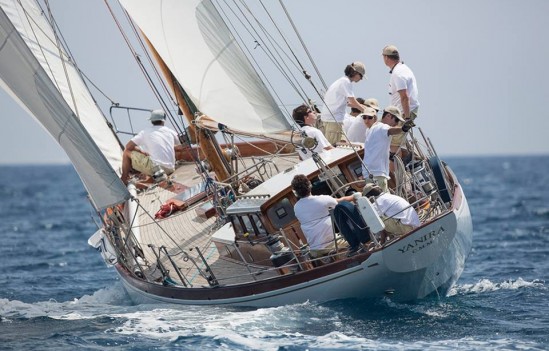
2017 JULY CLASSIC SAILBOAT OF THE MONTH – Yanira
Type: 12-Metre
ex, Ingeborg (1953-1960)
YANIRA Specifications:
LOA: 58.56′ / 17.85m
LWL:
Beam: 12.46′ / 3.80m
Draft: 8.53′ / 2.60m
Hull Number:
Designer: Bjarne Aas
Original Owner: Ragnar Appelgren
Current Owner:
Year Built: 1953
Built By: Fredrikstad (Norway)
Hull Material: Mahogony / Oak
Gross Displacement: 22 tons / 20,000 kg
Sail Number: ESP1257
Historical:
Yanira built in 1953 and launched in 1954, her first name was Ingeborg in honor of the wife and the daughter of Ragnar Appelgren, the Norwegian cosmetics Industrial who commissioned her construction. It is a unique model designed by Bjarne Aas under the international rule “12 meter Racing Class”.
Known Ownership History:
1954- 1960 – Ingeborg
1960- 1970 – Manuel Giro (name changed to Yanira)
1970 – 1983 – Syndicate (10 Friends of Mr. Giro)
1983 – 1983 – Luis Gil de Viedma and Federico García Planas
1983 – 2013 – Federico García Planas
2013 – xxxx – Society Regatta Experience SL (managed by Madrid and Andres Mora Magdalena Leon, Rafael Ramón-Borja and Vicente Nicolau Alicante)
Known Racing History:
Yanira is a very fast cruiser-racer with an extensive record of 24 wins since 1984, including seven Copa del Rey -six consecutivas- and three editions of the Puig Vela Classica Barcelona. Including two wins in Les Voiles de Saint Tropez (1999 and 2002 ) and even in IR Cruise General Alfonso XIII Trophy Barcelona- Menorca who won in 2000 and 2005 against modern ships.
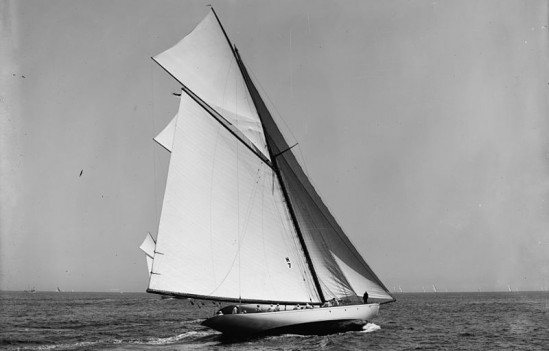
2017 JUNE CLASSIC SAILBOAT OF THE MONTH – Virginia
Type: NY 70
“Virginia” Specifications:
LOA: 106 ′ 0″ / 32.30m
LOD: 106′ 0″ / 32.30m
LWL: 70′ 0″ / 21.33m
Beam: 19′ 4″ / 5.89m
Draft: 14′ 0″ / 4.26m
Sail Area: 6,000 sq ft
Yard Number: 533
Hull Material: Wood
Designer: N.G. Herreshoff
Built by: Herreshoff Manufacturing Company, Bristol, RI
Year Built: 1899
Original Owner: W.K. Vanderbilt
Original Price: $32,594
Status: Destroyed
Historical:
Four boats were constructed for members of the New York Yacht Club. They were lightly built, raced hard, leaked extensively and only two boats continued sailing after the first year.
The NY 70s drew 14 ft, and were said at the time to be the fastest boats to cover a triangular 30 mile coarse (2.45 hrs), with eleven miles to windward! Responding with good humor, Mr. Herreshoff was asked by William O. Gay, who owned the 11 foot draft yacht Athene, when would there be a time when Athene could beat the NY 70s, Captain Nat responded when there is less than 14 feet of water.
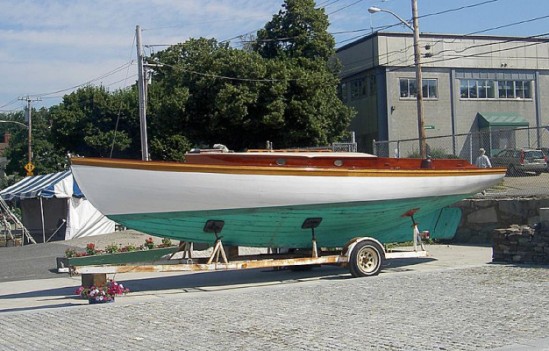
Type: Centerboard Yawl
PLEASURE Specifications:
LOA: 30’0″ / 9.14m
LWL: 24’0″ / 7.31m
Beam: 8’5″ / 2.58m
Draft: 31” / 0.76m
Hull Number:
Designer: N.G. Herreshoff
Original Owner: N.G. Herreshoff
Current Owner:
Year Built: 1924
Built By: Herreshoff Manufacturing Co., Bristol, R.I.
Hull Material: Wood
Gross Displacement: 7000 lbs
Sail Area: 445 sq ft
Sail Number:
Historical:
In N.G. Herreshoff’s words – “In 1924 when at 76 years and passing winters in southern Florida, I designed and had built a small cruiser to use in Biscayne Bay and about the Keys. This boat, Pleasure, was 30′ o.a., 24′ w.l., 8’5″ beam, 31” draft, ballasted by lead, which was part of keel & centerboard logs and some stowed inside. Rig: jib and leg-o-mutton mainsail with no bowsprit, of about 445 sq. ft. She appeared to be a good sailer and a real “ghoster” in light airs, and was easily the fastest boat about Biscayne Bay. My ordinary sailing was generally alone, and cruising with my wife only, and the boat had a comfortable cabin for it. I was sometimes bothered at moorings or to reef if overtaken by strong wind. With this rig, the boat appeared to do her best windward work, tacking
in about 7 points.”
“The second year, I changed the rig to yawl by cutting off the boom and aft part of the mainsail and adding a mizzen mast with sail [having] 1/2 hoist & boom as [the] cut-down mainsail. The total sail area very little increased by the change. Not having a standard to go by, I could not gauge the speed efficiency of the boat, but the loss was
small and not apparent in sailing alone.”
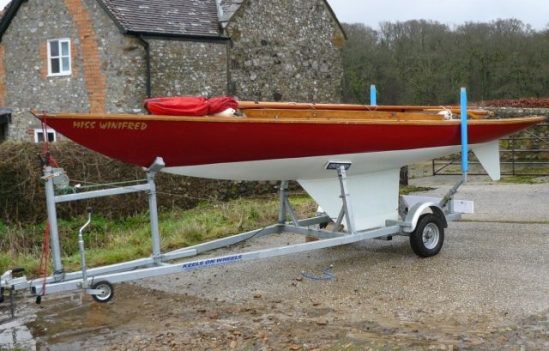
2017 MAY CLASSIC SAILBOAT OF THE MONTH – WINIFRED
Type: 1/2 Rater
LOA: 23’10″ / 7.26m
LWL: 16’3″ / 4.95m
Beam: 4’6″ / 1.37m
Draft: 3’0” / 0.91m
Rig:
Design Number: 425
Designer: N.G. Herreshoff
Original Owner: Wee Winn – Eloise Cochrane, Bideford, England / Winifred – Brian Corbett
Current Owner: Wee Win – Herreshoff Museum / Winifred – Brian Corbett
Year Built: Wee Winn 1892 / Winifred 1999
Built By: Herreshoff Manufacturing Co.
Hull Material: Wood
Gross Displacement: 3 CWT
Sail Area:
Sail Number:
Historical:
In 1891 Nat Herreshoff invented the fin keel. He sent two yachts of this type, the Wee Winn and the Wenona to England. The Wenona won 17 out of 20 races, the Wee Winn won 20 out of 21 races. These fin keelers were so successful that they were effectively barred from competition.
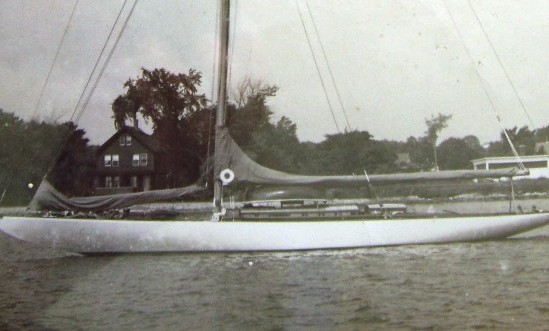
2017 APRIL CLASSIC SAILBOAT OF THE MONTH – Georgia
Type: Larchmont O Class
LOA: 58’0″ / 17.67m
LOD: 58’0″ / 17.67m
LWL: 38’6″ / 11.76m
Beam 12’0″ / 3.65m
Draft 7’6” / 2.28m
Hull Number: 215427
Designer: William Gardner
Original Owner: Charles Lane Poor
Built: Spring of 1917
Built By: Wood & McClure of City Island New York
Contract Cost: $10,000
Hull Material: Oak Frames Mahogany Planking
Displacement: 35,500 lbs
Rig: Gaff (adapted to Marconi by Gardner in 1926)
Sail Area: 1,670 sq ft
Historical:
The Class Symbol is an “L” Inside a Circle.
Edmond Fish was instrumental in getting the Larchmont Yacht Club to form and build this one-design class boat which was designed by William Gardner to the Universal Rule. Six boats were initially ordered by the Larchmont Yacht Club, but 4 were launched and tried out first in the Spring of 1917.
All boats were built by (“Woods”) Wood & McClure, and were favorably commented on by those who have seen them sail. But as it was the Larchmont Yacht Club had suspended all of its open regattas in 1917.
215427 “Georgia” – Charles Lane Poor (author of “Men Against the Rule”) – Gaff Rig – L1
xxxxxx “Varuna,” – James B. Ford of Rye, NY (Former Commodore of Larchmont Y C) – Marconi Rig – L2
215428 “Nimbus” – E. P. Alker and sailed by Edmund Fish in the Summer races – Gaff Rig – L-3
215496 “Grey Dawn” – Philip H. Johnson (of Philadelphia) – Gaff Rig – L4
215497 “Maisie” – A. Brian Alley – Gaff Rig – L5
xxxxxx “Betty” – Harold L. Foss – Gaff Rig – L6
One of the original 6 boats built was still not commissioned after 2 years and was seeking a purchaser in 1919, possibly due to World War I lasting until 11 November 1918
Georgia carried around 270 sq ft more sail area than the P class racers. More area in proportion to their displacement the Os should be relatively faster. With finer more graceful lines than the NY 40s, but with less sail area, still should be relatively faster than the 40s as well.

2017 MARCH CLASSIC SAILBOAT OF THE MONTH – Yvette
Fife “Yvette” Specifications:
LOA:
LOD: 27′ 2″
LWL: 16′ 6″
Beam: 6′ 7″
Draft: 4′ 5″
Hull Number: 449
Rig: Sloop
Sail Area: 366 sq ft / 34 m2
Designer: William Fife III
Built by: William Fife & Son
Original Owner: Donaldson
Year Built: 1899
Historical:
Yvette was one of the last Fife to leave Scotland, and was built for the Donaldson family, who were among some of Fife’s most important clients. Three sisterships were built to the same design, 1898 Mignon, 1899 Yvette and Pierrette. The design was believed to be inspired by Sir Thomas Lipton’s commission for his 1899 America’s Cup challenger Shamrock.
2017 FEBRUARY CLASSIC SAILBOAT OF THE MONTH – Scalett O’hara
Scalett O’hara Specifications:
LOA: 12.70m * LWL: 9.5m * Beam: 2.23m * Draught: 1.48m * Displacement: 2.72tonnes
Historical:
Jonas Brundin is the Swede who came to Australia in 1992 as a business migrant bringing with him the plug for the 30-square-metre yachts, a Harry Becker design. He joined up with Garth Stewart and John Taylor with the view of building 30-square-metre yachts in Australia.
The three fibreglass 30-square-metre yachts were launched in 1993.
Pinchgut and Business Class (originally SAS Business Class) were built at Boatspeed in Gosford (which has since gone bust). They have a hand- laid foam-sandwich hull and deck.
The original Swedish hull which acted as the plug for the Australian mould was sold to Ross Wilson in Lake Macquarie. Ross named it Wisper. In 1994 Robert Skol purchased it from Ross, sailed it back to Sydney Harbour and re-named it Scarlett O’Hara.
The Australian mould was kept at John Taylor’s factory in Rouse Hill, but unfortunately, since John passed away nobody knows what became of the mould.
Scarlett O’Hara has had, and continues to have a very active presence on Sydney Harbour. She sails in multiple clubs and attends almost every big event on the water. The passion in her name describes her well as she is often flaunting her good looks with an invigorating experience for her crew.

2017 JANUARY CLASSIC SAILBOAT OF THE MONTH – Solo
Solo Specifications:
LOA: 57’0″ / 17.37m
LWL: 49’0″ / 14.93m
Beam: 13’0″ / 3.96m
Draft: 8’0” / 2.43m
Hull Construction: Transverse Steel
Designer: Alan Payne
Original Owner: Vic Meyer
Current Owner: Solo Adventure Sailing
Year Built: January 2, 1955
Built By: Sydney Ironworks factory
Gross Displacement:
Mast Height: 56′ 0″ / 17m
Home port: Royal Queensland Yacht Squadron Manly Harbor Village
Engine: 120 hp diesel Perkins 6-cylinder compression ignition start
Historical:
Solo was built in 1955 in a Sydney ironworks factory by a Swiss engineer named Vic Meyer from Solothurn, Switzerland. It took two years to build Solo; Meyer and his son, Vic Meyer, Jr. did almost all of the work themselves.
The boat was designed by naval architect Alan Payne, who also designed Australia’s first America’s Cup challenger Gretel and Gretel II. When Solo was designed she was designed for cruising, but when Meyer tested her on her first sea trial Meyer saw that she was an extremely fast boat, so he decided to do some race sailing with her; from here on Meyer and Solo become recognized around the world for their feats and adventures.
Solo’s racing career lasted for eight years (1955 to 1963). During that time Solo had won over 80 different races, never finishing worse than fourth place. Some of the more well-known races she won include winning the Rolex Sydney to Hobart four times, the Brisbane to Gladstone five times as well as a Trans Tasman Auckland to Sydney race. Unfortunately for Meyer, after winning all of those races nobody wanted to race Solo because they knew they didn’t stand a chance because of her sleek lines, so Meyer started to lack the competition, he was also getting old in age, he was already 50 by the time he stated racing Solo, so he gave up racing after becoming a life member of the cruising yacht club of Australia and decided to do some cruising.
Cruising Career:
Meyer started off with a solo circumnavigation around Australia; it took him 13 weeks to complete. When Meyer arrived back in Sydney he found out he was the second man to solo circumnavigate Australia since Matthew Flinders back in 1802. After he circumnavigated Australia he decided he wanted to do a bigger adventure and sail around the world. To sail around the world Meyer needed a crew; he was very known for picking all women crew at the time, because he said they worked harder and didn’t complain as much. After his first voyage he went on to do it twice more surviving numerous groundings, a cyclone that almost sunk the boat and a demasting in the middle of the Pacific Ocean, again with all female crew. After his circumnavigations he decided that he was going to sell the boat, but before he sold Solo he wanted to make one more trip around Australia.
In Sydney, before departure a lady called Olga stepped on board; she was Meyer’s only crew member at the time. Meyer left port around mid-April and sailed around the country. On Monday 14 April, it was overcast and with no offer of a chance to get a sight, that night the radar and echo sounder broke down, through battery failure it is believed, but there seemed no cause for immediate worry. Although a squally south Easter was blowing, everything pointed to Solo being well offshore. Meyer left the autopilot in charge for a while as he attempted to get the radar going again, but while plunging through a squall Solo went through the surf and onto the beach at Fraser Island at a spot about ten miles south of Happy Valley. The tide was well in and when it receded Solo was left high and dry. There she remained for over a month. Unfortunately, she had dug herself into the sand, a plan to bulldoze a channel out to the sea was not practical, and an attempt to tow her off had failed.
On Thursday, May 15, Solo was refloated by Brisbane salvage expert Joe Engwirda and the help from a high tide, after a two-day operation which had only one anxious moment when she was caught side-on by a large breaker she was floating, once clear of the breakers and into deep water a diver inspected Solo’s hull only to find the only apparent damage was done to the rudder. Solo was towed by Mr Engwirda’s barge to Mooloolaba 50 km south of her location, she was then towed to a boat yard where she had repairs carried out. During Meyer’s stranding he proposed to Olga after she refused to leave him and the boat at Fraser Island. Olga was 25 and Meyer was 70. After Meyer and Olga got married they sold Solo and bought a mango farm on the Sunshine Coast Queensland. One night Vic and Olga were driving home, they were towing a caravan at the time and they had to cross a narrow bridge only suitable for one car at a time, already half-way across the bridge, a truck started to approach from the opposite direction, and to avoid a collision Vic had to steer off the bridge, unfortunately he did that and during that accident Olga drowned. After that accident Meyer sold his mango farm and moved back to Sydney to live the rest of his days. Vic Meyer died in 1993. Meyer had sailed over 300,000 nautical miles during his career.
Antarctic Expedition
Solo was sold to the Oceanic research foundation (A.K.A.ORF) the ORF wanted to take the boat to the Antarctic’s for a scientific expedition, but they couldn’t unless they found themselves a sponsor, after weeks of searching Australian entrepreneur Dick Smith took the job of sponsoring the boat finally after having a complete refit, the boat set sail in late 1977 with famous New Zealand sailor Dr David David Lewis at the helm, during the voyage Solo hit an iceberg which had breached the hull on the port side bow just under the waterline, the crew started to throw things overboard to try to keep the boat afloat, while that was happening the only female on board also the only one to bring a pillowcase stuck the pillowcase over the breach while another crew member smeared concrete over the pillowcase to create a seal, the crew had no other option then to turn around and head home for repairs, when in port the crew said without that patch Solo would have sunk for sure after the repairs were carried out Solo sailed back to the Antarctic to complete her voyage. after the Antarctic expedition the ORF was in need of a bigger boat because Solo could only sleep six at the time.
Commercial Life
“Solo” was sold to Jill and Trevor Cook in 1978 who modified her to meet passenger survey regulations and commenced day sailing charters in the Whitsundays giving their guests the thrill of sailing out to a coral reef on a true racing yacht for snorkeling and lunch before sailing back in the afternoon. During these cruises guests had the opportunity to assist with the sailing and hoisting the spinnaker was a common occurrence. “Solo” was the first racing yacht to operate commercially in Queensland. Cooks then purchased Gretel in 1981 operating both yachts until selling “Solo” in 1984. “Solo” had a number of different owners after that whilst doing 3 day charters. In the late 1980s her owners at the time had financial difficulties and she was auctioned in Cairns. This auction caught the attention of a Brisbane businessman who thought it would be an excellent idea if such an icon was brought to the bayside suburb of Manly, Queensland, he did just that, he purchased the boat and brought it down to Manly where she was put into commercial survey and now operates charters to local islands in Moreton Bay. Solo was sold again in 2005 to a business Lady who with her son operates “Solo” Adventure Sailing
Sydney Hobart Race Winners:
1945: Rani 1946: Morna 1947: Morna 1948: Morna 1949: Waltzing Matilda 1950: Margaret Rintoul 1951: Margaret Rintoul 1952: Nocturne 1953: Solveig IV 1954: Kurrewa IV 1955: Even 1956: Kurrewa IV 1957: Kurrewa IV 1958: Solo 1959: Solo 1960: Kurrewa IV 1961: Astor 1962: Ondine 1963: Astor 1964: Astor 1965: Stormvogel 1966: Fidelis 1967: Pen Duick III 1968: Ondine II 1969: Crusade 1970: Buccaneer 1971: Kialoa II 1972: American Eagle 1973: Helsal 1974: Ondine III 1975: Kialoa III 1976: Ballyhoo 1977: Kialoa III 1978: Apollo 1979: Bumblebee IV 1980: New Zealand 1981: Vengeance 1982: Condor of Bermuda 1983: Condor 1984: New Zealand 1985: Apollo 1986: Condor 1987: Sovereign 1988: Ragamuffin 1989: Drumbeat 1990: Ragamuffin 1991: Brindabella 1992: NZ Endeavour 1993: Ninety Seven 1994: Tasmania 1995: Sayonara 1996: Morning Glory 1997: Brindabella 1998: Sayonara 1999: Nokia 2000: Nicorette II 2001: Assa Abloy 2002: Alfa Romeo I 2003: Skandia 2004: Nicorette III 2005: Wild Oats XI 2006: Wild Oats XI 2007: Wild Oats XI 2008: Wild Oats XI 2009: Alfa Romeo II 2010: Wild Oats XI 2011: Investec LOYAL 2012: Wild Oats XI 2013: Wild Oats XI 2014: Wild Oats XI 2015: Comanche 2016: Perpetual Loyal
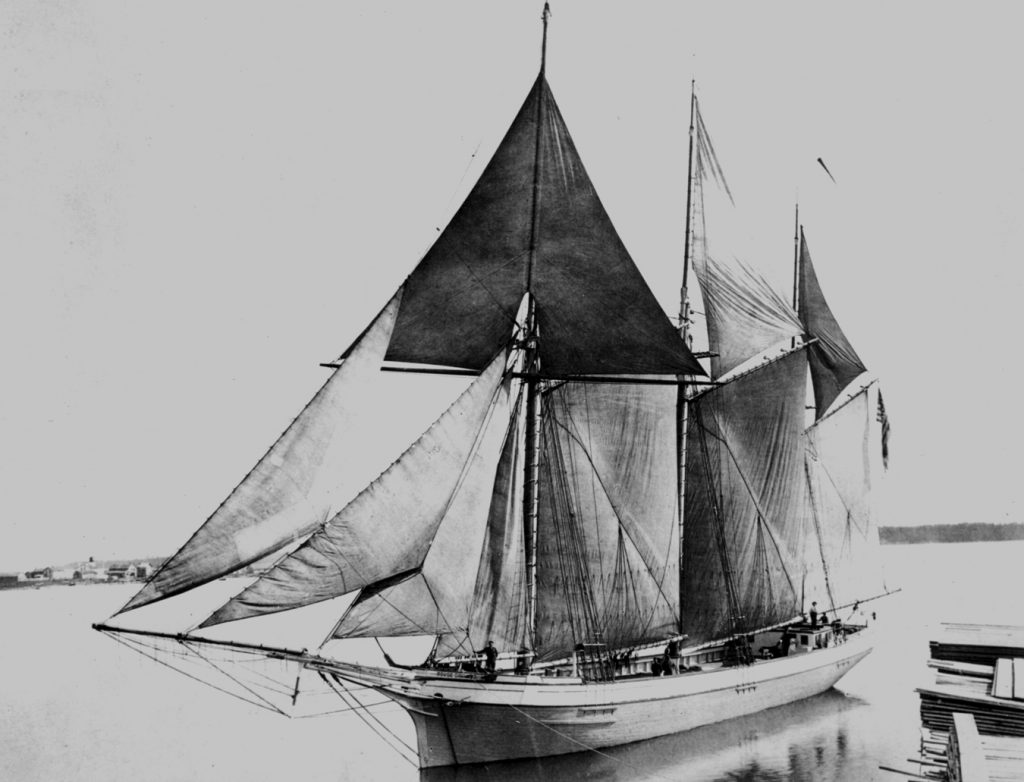
2016 DECEMBER CLASSIC SAILBOAT OF THE MONTH – Rouse Simmons
“The Christmas Tree Ship”
“Rouse Simmons” Specifications:
LOA: 123.5 ft (37.6 m) – Beam: 27.6 ft (8.4 m) – Height: 8.4 ft (2.6 m) – Hull Number: US 110087 – Tonnage: 205 GT/195 NT – Launch Date: August 15, 1868 – Builder: Allen, McCelland & Co., Milwaukee, Wisconsin – Contracted By: Rouse Simmons. – Status: Foundered and sunk on November 23, 1912
Historical:
The Rouse Simmons was built in Milwaukee in 1868 by Allan, McClelland, & Company, and named after a Kenosha businessman Rouse Simmons. The schooner was soon purchased by wealthy lumber magnate Charles H. Hackley of Muskegon, Michigan and joined his sizeable fleet. Hackley’s ships served across most of Lake Michigan’s coastline, and the Rouse Simmons became a workhorse, shipping lumber from company mills to several ports around the lake for around 20 years. At its peak the schooner was making almost weekly runs between Grand Haven and Chicago.
After its service for Hackley the ship exchanged hands several times. Many similar schooners were also frequently sold and they became known as “tramp ships”. In 1910 Herman Schuenemann bought an interest in the ship, expanding that to an eighth in 1912. The other shares were owned by Captain Charles Nelson of Chicago, who owned one eighth and would sail alongside Schuenemann on the fatal journey, and three fourths (the commanding share) were owned by Mannes J. Bonner, a businessman from St. James, Michigan.
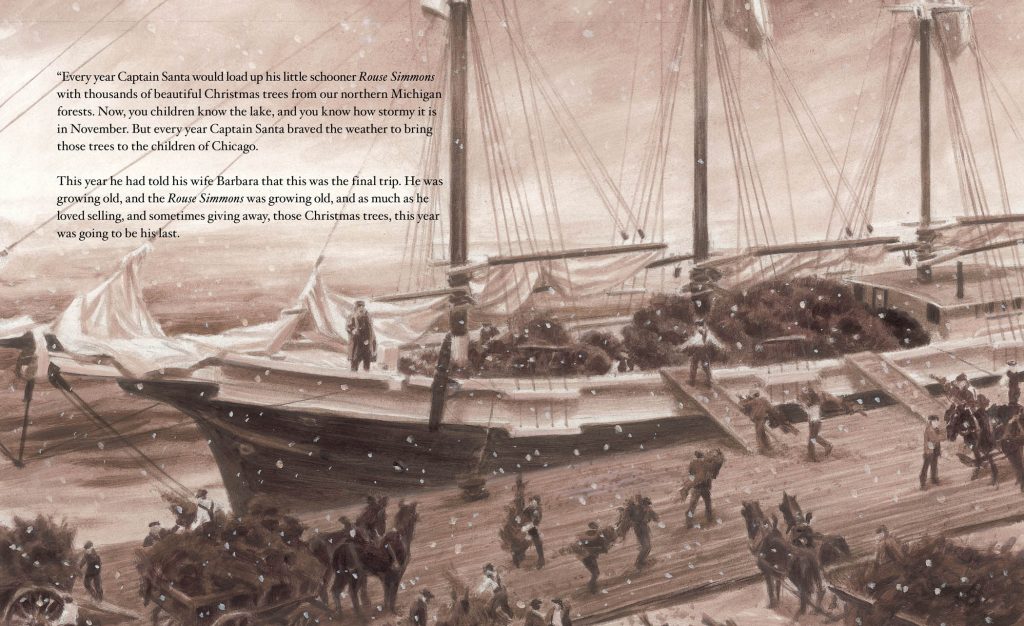
“The Christmas Tree Ship”
The Schuenemann brothers, Herman and August, had been trading Christmas trees in Chicago since around the start of the 20th century. August died in November 1898 aboard the S. Thal – a 52-ton, two-masted schooner – when it sank in a storm near Glencoe, Illinois. His younger brother continued the family business. While many rival traders had sold to wholesalers and local grocers, Schuenemann sold directly to Chicago residents at dockside by Clark Street Bridge. By cutting out the middleman in this way the trees could be sold cheaply while still making a profit. The venture used the slogan “Christmas Tree Ship: My Prices are the Lowest”, with electric Christmas lights and a tree atop the main mast. The trees were sold for between 50 cents and $1, but Herman Schuenemann, affectionately known as “Captain Santa”, also gave away some of the trees to needy families.
Final Journey:
Schuenemann loaded the schooner with 5,500 trees from Thompson Harbor near Manistique, Michigan and planned to make the week-long journey to Chicago. The difficult weather had discouraged his competitors from making their own journeys, and snow had covered the tree farms in Michigan and Wisconsin. He hoped that the resultant shortage of Christmas trees would lead to a huge profit and solve his financial problems.
Already by 1912, November had a reputation for especially violent storms on the Great Lakes. November 1912, however, had been relatively quiet, with only one significant storm so far, which affected especially southeastern Michigan and northwestern Ohio. (The reports that say another storm had already taken many lives and ships that month are erroneous, confusing 1912 with the Big Blow of 1913.) Still, a second storm was brewing. The conditions of the day were very poor, with many ships anchoring in port for shelter to avoid being battered by the 60 mph winds that could be anticipated in a November gale.
Local legends say that some sailors refused to board the ship and that the vessel was unseaworthy. Two years previous the schooner had been towed to port by The Grand Haven Tribune after it was found riding low in the water. Despite this the journey began at noon, with trees crammed into every possible corner of the ship. The weight of the trees was far above recommendations, especially in the bad winter weather, and was certainly going to contribute to the tragedy. During the night, with storms hitting the Simmons hard, two sailors were sent to check the lashings on deck. Both seamen were swept overboard by a giant wave that collected them, many bundled trees, and a small boat. Now that the schooner was slightly lighter and more maneuverable Captain Schuenemann directed it towards Bailey’s Harbor. Suddenly, and tragically, the storms worsened; ice formed on the sodden trees and winds battered the hull.
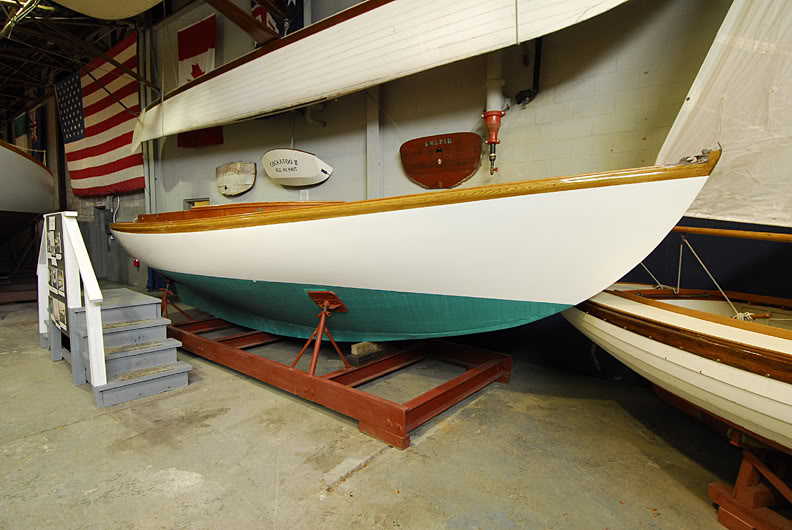
2016 NOVEMBER CLASSIC SAILBOAT OF THE MONTH – Sadie
In 1912 Nat Herreshoff at age 63 carved a half- model of a daysailer with a new form that inspires to this day.
“Sadie” Specifications:
LOA: 27′ 0″ – LWL: 21′ 9″ – Beam: 8′ 0″ – Draft: 2′ 8″ – Hull Number: 732 – Contract Date: 3/17/1914 – Contracted By: Elias Cornelius Benedict (Wall Street investor and former Seawanka Corinthian Yacht Club Commodore) – Original Price: $1,850 – Designer: N.G. Herreshoff
Ownership History:
1914 – 1920 – Elias Cornelius Benedict
1920 – 1973 – James Greenway – Cos Cob, CT
1973 – 1992 – Chesapeake Bay Maritime Museum St. – Michaels, MD
1992 – XXXX – Herreshoff Marine Museum – Bristol, RI
Historical:
In 1914 hull number of 732 was commissioned by E.C. Benedict, and was a further improved Alerion design. In order to make her less tender and wet in choppy conditions, Sadie was designed with more length, beam, flair, and internal ballast than her predecessor.

2016 OCTOBER CLASSIC SAILBOAT OF THE MONTH – Finisterre
S&S “Finisterre”
LOA: 38′ 6″ / 11.76m
LWL: 27′ 6″ / 8.41m
Beam: 11′ 3″ / 3.44m
Draft: 5′ 10″ / 1.55m
Design Number: 1054
Rig: Bermudan Yawl
Displacement: 18,640 lbs
Sail Area: 713 sq ft
Designer: Sparkman & Stephens
Built By: Seth Peterson, Old Saybrook, Connecticut
Original Owner: Carleton Mitchell
Current Owner:
Designed: 1954
Historical:
Finisterre was built by Seth Peterson of Old Saybrook, Connecticut and launched in 1954. The owner chose Sparkman & Stephens in great part due to his relationship with Rod Stephens with whom he had sailed with quite a bit on Rod’s NY32, Mustang. As Mitchell himself said “Although it was my privilege to sail with many of the top sailors of the era, I don’t think anyone else combined knowledge of deck layout, rigging and sails. ” Olin Stephens’ innovative design genius, as exemplified by such diverse vessels as Dorade, which revolutionized ocean racing, and the super-J boat, Ranger, and it was easy to see why S&S was the go-to team.”
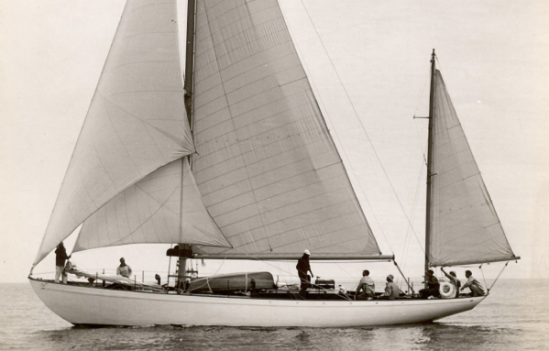
2016 SEPTEMBER CLASSIC SAILBOAT OF THE MONTH – SKYLARK of 1937
“Vryling” Specifications:
Current Name: Skylark of 1937, ex Vryling
LOA: 53′ 0″
LWL: 38′ 0″
Beam: 12′ 0″
Draft: 7′ 7″
Design Number: 146
Rig: Yawl
Displacement: 45,725lbs
Sail Area: 1,981 sq ft
Designer: Sparkman & Stephens
Built By: Pendleton Yacht Yard of Wiscasset, Me
Original Owner:
Current Owner: Tara Getty
Launched: 1937
Sail Number:
Known Racing History:
2013 – Argentario Sailing Week Race Winner
2013 – Les Regates Imperiales in Corsica Overall Regatta Win 2, 1, 1, 2
2013 – PUGS Regatta Saint-Tropez Winner
2012 – The Blue Bird Cup (the winner of a race between Skylark and a yacht she chooses to challenge in a head-to-head sailing competition) Wins over Argyll
2012 – Les Voiles de Saint-Tropez Race Winner 1-2-2-1
1950 1951 – Newport to Ensenada Race Winner
Known Restoration History:
2003 Loughborough Marine Interests – substantial restoration, from the lead keel up, of a very miss-shapen, partially rotten or broken hull and deck structure. The interior, a portion of which being original 1937, was carefully removed along with the “gutting” of machinery and systems. Shipwright work began with stabilizing the existing structure, removal of multiple frames and planking, and lifting the hull off the lead keel. Working from lines plans and construction drawings, the original S&S design hull shape was reformed at each station with temporary ply bulkheads.
This complete, began the significant project of minor repairs to the wood keel and stern post and the total replacement of the stem and horn timber in oak. From there completely reframed the hull with steamed oak laminations, templated and installed all new bronze floors, then placed the ‘hull’ back onto the lead keel with all new bronze bolts.
The next phase was to re-plank the hull, tight seam above the waterline and caulked seam below, with pattern grade mahogany, bronze riveted onto the frames. After replacing the stringers, and the substantial work of replacing the shelf, clamp, fairing the sheer line, and installing new bulkheads, work began laminating up new fir and oak deckbeams, followed by two layers of plywood, a layer of glassfibre and finished with hand laid teak.
2008 East Passage Boatwrights – EPB built and installed deck joinery, hatches and cap rails and the galley. EPB managed and assisted in the installation of systems including the auxiliary propulsion, plumbing and electrical systems. EPB also constructed a new box section boom. In 2011, she was sold to her current owner who changed her name to SKYLARK of 1937. EPB was tasked with the customization of the interior including constructing a bunk and hanging locker in the fo’c’sle, new refrigeration in the galley, and a refit of the head. The steering system was changed from tiller to a wheel. EPB assisted in the design and installed the stunning white bronze steering pedestal with matching skylight binnacle manufactured by Historical Arts & Casting of West Jordan, Utah and manufactured the ship’s wheel.
Historical:
Skylark, design 146, was a further improvement of Stormy Weather (design 27), Avanti (design 85) and Sonny (design 94) In 1972 Skylark completed a 31,106 mile circumnavigation. 2013 Currently sailing and racing in the med.
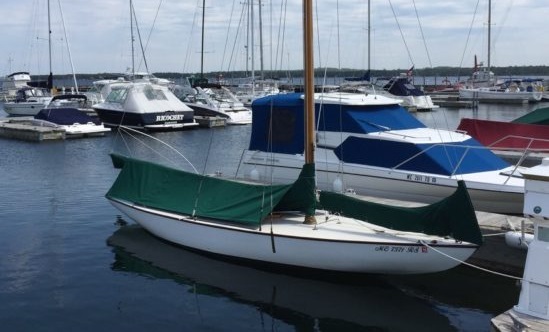
2016 AUGUST CLASSIC SAILBOAT OF THE MONTH – CORI I
Type: Corinthian One-Design
ex, Ding Bat?
LOA: 24’9″ / 7.58m
LWL: 15’0″ / 4.57m
Beam 6.1′ / 1.85m
Draft 4’11” / 1.25m
Hull Number: 31b(c)(d)
Designer: John G. Alden
Original Owner:
Current Owner: Allan Brouillet
Year Designed: 1913
Built By: Stearns & McKay, Marblehead, MA
Hull Material: 11/16″ cedar planking, oak frames
Gross Displacement:
Ballast: 1,200 lbs (iron)
Sail Number:
Sail Area: 310 sq ft
Contract Cost: $550.00
Historical:
Current Owner Allan Brouillet – I am presenting the following history of the sailboat that Brenda and I named “Cori 1”, the last remaining Alden Corinthian class sailboat, as it was relayed to us by the prior owner, Dr. James Ross, then of Sandusky, Ohio. Some of the history is based on written documentation, which is attached. Some is based on verbal history passed down through the prior owners, of which Brenda and I are the current owners. Brenda and I cannot vouch for the degree of accuracy of the verbal history, but instead of risking its loss, I am passing it to you as accurately as we remember it.
During 1912 John Alden designed a knockabout sailboat as a fleet racer for the sailors of the Corinthian Yacht Club of Marblehead, Massachusetts. He named the sailboat design the “Corinthian”. It was initially designed as a gaff rig sloop and was identified in Alden records as design #20. Sometime during the construction process a decision was made to construct some of these boats with a Marconi rig. The Marconi rig Corinthian was given a separate design number, this being #31. In 1993 correspondence to Dr. Ross, an Alden Co. representative indicated assigning a separate design number based on rig type for the same hull was not “customary routine”. Regardless, a number of the Corinthians were constructed with the Marconi rig including Cori 1. For both designs, the large area of the mainsail resulted in a mainsail boom that extends beyond the stern necessitating the use of running backstays. Accompanying this history are the design #20 and #31 drawings. Both show the use of a block system to release and tighten the running backstays. However, Cori 1 employs a bronze running backstay track with a track car and a car lock. Since she is the last surviving Corinthian we assume that some of the other Corinthians also employed this running backstay track design. It may also have been a later upgrade that was acquired by a subset of the Corinthian owners.
Based on verbal history relayed to me by Dr. Ross, sometime thereafter (most likely during the 1930’s) the General Electric Company (GE) bought some of the remaining Corinthians from the Corinthian Yacht Club boat owners and transported the boats to a GE corporate retreat located on Lake Champlain. The boats were made available for use to those people staying at the retreat. Given the Corinthian’s club racing roots it seems inevitable that the sailing characteristics of the Corinthian would eventually exceed the capabilities of an unfortunate person at the tiller, and as a result, the boat (or possibly some boats) sunk. To prevent this event, or events, from happening again, GE constructed flotation tanks for the Corinthian(s). Two elongated tanks were placed in the stern on either side of the rudder post, and one flotation tank was placed forward of the mast. These tanks made the Corinthian unsinkable. Copper was used to construct the tanks. We acquired Cori 1 with it’s three copper flotation tanks. One of the stern tanks has a dent in it but is still sound and watertight.

As relayed to us by Dr. Ross, he came upon what turned out to be the last remaining Corinthian at a farm near Lake Champlain. The owner had used Star class sails as replacement to the original sails. In addition, the owner had used a Star tiller handle. The copper flotation tanks were found stored under the front porch. Dr. Ross bought the boat and proceeded with his restoration efforts. As we understand them, these restoration efforts included replacement of rotted boards, chinking, new decking, new sails, and painting and detailing. A motor mount was also fabricated and a motor added (British Seagull) to better negotiate the boat through modern docks and marinas. Dr. Ross also converted a mobile home trailer to become a mobile cradle for the boat. With this mobile cradle he was able to transport the boat to different locations, including various wooden boat shows. During the early 1990’s Dr. Ross sought information from the Alden Company regarding the history of the Corinthian. In its responses (attached) the Alden Company indicated that this was the last remaining Corinthian, that is was Alden’s Design #31, and that it was likely the oldest remaining Alden boat design still in active use.
Brenda and I first saw the Corinthian in the “For Sale” pages of a 1998 Wooden Boat Magazine. We had been wanting to experience some of the “art” of sailing and immediately appreciated her lines. We eventually purchased the boat, and all related equipment, from Dr. Ross. We, with the help of so many others, worked to further restore and maintain Cori 1 and her mobile cradle. We made the six cradle supports fully adjustable to allow for easier completion of yearly maintenance work and to better balance storage and transportation pressures on the hull. Shortly after our purchase we discovered small areas of rot and knew this would be an ongoing problem, made worse by her new location in the colder freshwaters near our then hometown of Bay City, Michigan. In consultation with various people knowledgeable in boat preservation we decided to employ Gougeon “West System” epoxy techniques specifically designed for carvel planked hulls. A two part epoxy paint (Awlgrip) was used as the final outer coat. These actions have worked perfectly to protect her over these past 18 years of use A new tiller handle was also made for her. Upgrades were made to bring electricity on-board which allows for night sailing, marine radio, and party music. As a knockabout no seating was designed into either version of the Corinthian. Since we have aged with Cori 1 we decided to add bench seating. We were able to design and construct mahogany seating that non-intrusively “clamps” to Cori 1’s mahogany floorboards. These seats can be removed and reinstalled as desired. Attached are pictures taken of her during last year’s sailing season (2015). We will be sailing her again this year. She is currently docked and stored at the Irish Boat Yard in Charlevoix, Michigan.
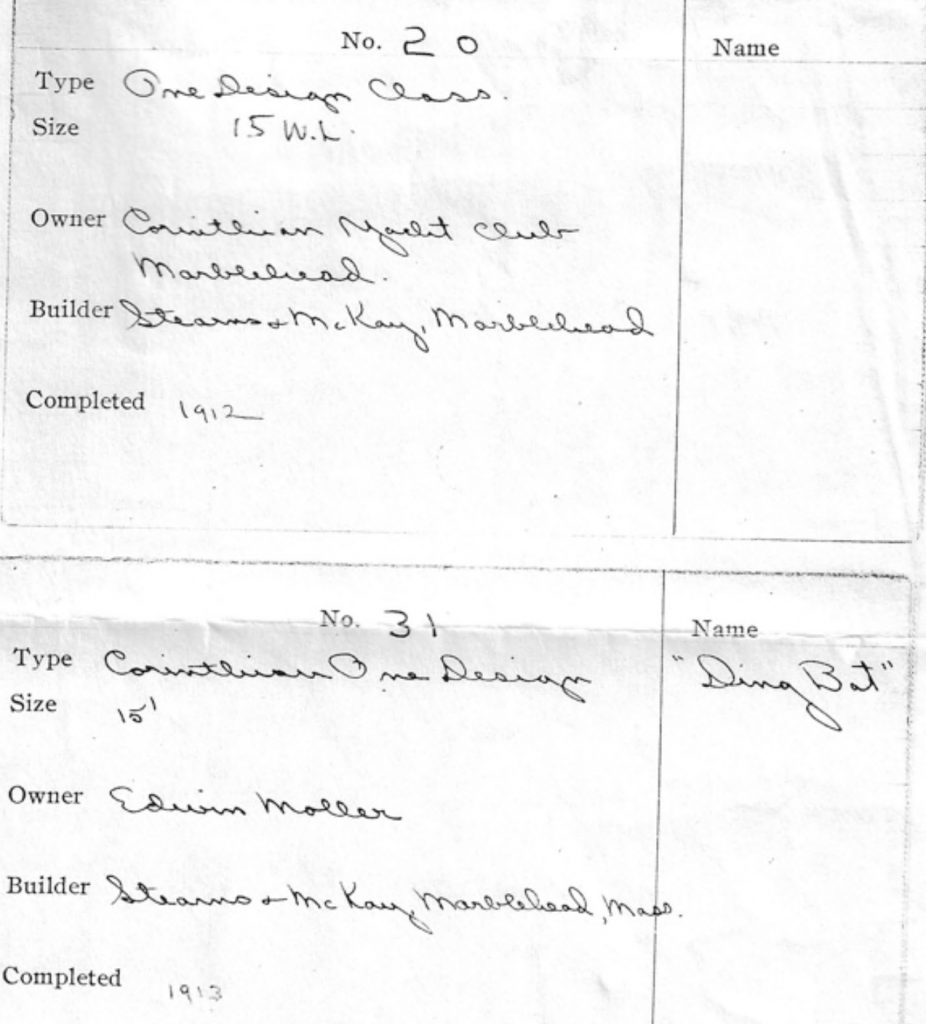
As you may be aware the Alden Company is no longer in business. We learned that M.I.T. maintains a collection of Alden Company documents and designs and a registry of Alden boats (the Hart Collection). We also learned that the registry has the Corinthian boat that Brenda and I named “Cori 1” listed as being named “Dingbat”. As indicated in one of the attached documents a Corinthian Marconi rig sloop is identified as being named “Dingbat” (an old loggers tool). We discussed this matter briefly by email with a representative at M.I.T. Based on that discussion we cannot see any facts that directly link our Corinthian to the one in the picture so we continue to know her as “Cori 1”. However, for similar reasons our “Cori 1” is identified as “Dingbat” in the M.I.T. registry.
As stated previously, this presentation represents our current understanding of her history based on written and verbal information provided to us. We hope that additional information may become available in the future that will better clarify and provide additional accuracy to the history of the last remaining Corinthian, Cori 1.
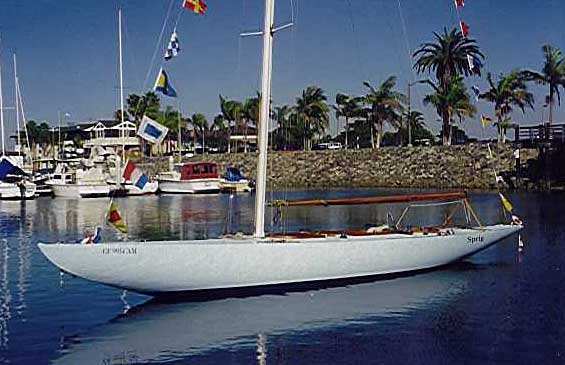
2016 JULY CLASSIC SAILBOAT OF THE MONTH – SPRIG
Type: 6 mR Class
LOA: 37′ O” / 11.27m
LOD: 37′ O” / 11.27m
LWL: 22′ 9″ / 6.93m
Beam: 6′ 0″ / 1.82m
Draft: 5′ 6″ / 1.67m
Displacement: 10,000 Lbs.
Designer: Clinton Crane
Year Built: 1930
Built to: Rule 2
Hull: Mahogany Planking on Steam Bent Oak Frames
Builder: Nevis Yacht Yard, City Island, N.Y.
Original Owner: Robert Smith, St. Louis, MO
Current Owner: Greg Stewart and Mike Thomas
Home Port: San Diego Yacht Club, San Diego, CA
Rig: 1934 updates to the Rule
Sail Area:
Sail Number: US-43
Historical:
Sprig – Reference to the Sprig duck that has a distinctive pintail was designed by Clinton H. Crane in 1930 and built by the Nevis Yacht Yard, City Island, N. Y. for Robert Smith of St. Louis, MO. Built to Rule 2, with her rig later modified by S&S in the mid 30’s to take advantage of the 1934 updates to the Rule. Owners Greg Stewart and Mike Thomas put in a tremendous amount of work to make ‘Sprig’ as beautiful now as she ever has been. She carries her original 3 spreader, 1 jumper rig and bright finish boom. Besides being taken down to bare wood inside and out, Sprig received full length epoxy soaked e-glass splines.This method has been successfully employed for 20 years by many Pacific Coast (PC) Class boats in San Diego. She has 3 cockpits and not even the helmsman gets a seat. Sprig traveled to Seattle in 2001 and 2002 and was always in the hunt. She placed second in the 2002 Lipton Cup and 4th in the 2002 North Americans. Sprig is very active in the San Diego Ancient Mariner events and is based at San Diego Yacht Club. Sprig received a new deck and other refurbishment and was relaunched in October 2005. Sprig is the most far-flung member of the Puget Sound Six Meter Association and recently competed at the 2009 World Cup in Newport, Rhode Island. In order to qualify for the Baum + Koenig Trophy at the 2009 Worlds, Sprig ordered a full suit of Dacron sails to replace her modern versions. She ended 13th of 24 and took home the KSSS trophy for the highest placing Rule 1 or 2 (unmodified keel) boat at the Worlds.
Known Racing History:
2015 – 6mR Invitational Regatta – St. Francis Yacht Club – Rule 2 Winner
2009 – World Cup in Newport – Rule 1 and 2 Winner
2002 – San Diego Yacht Club’s Opening Day Inspection – Best Maintained Classic Boat
2001 – San Diego Yacht Club’s Opening Day Inspection – Best Maintained Classic Boat
2016 JUNE CLASSIC SAILBOAT OF THE MONTH – ZACA
ZACA Specifications:
LOA: 118’0″ / 35.96m
LWL: 95’11″ / 29.23m
Beam: 23’9″ / 7.23m
Draft: 14’0” / 4.26m
Hull Number:
Designer: Garland Rotch
Original Owner: Templeton Crocker
Contract Cost: $200,000.00
Current Owner: Roberto Memmo, Monaco
Year Launched: 1929
Built By: Nunes Brothers Boat and Ways Co., Sausalito, California
Hull Material: Alaskan Cedar/Teak
Gross Displacement: 122 tons
Sail Area:
Sail Number:
In The Wake Of The Zaca: Video
Historical:
118 foot Schooner “Zaca”, which means “peace” in Samoan, was designed by Garland Rotch and built by Nunes Brothers Boat and Ways Co., Sausalito, California, for Templeton Crocker (grandson of Charles Crocker, one of the “big four” who built the Central Pacific Railroad.) Zaca was Launched in 1929 and christened by Academy Award winner Marie Dressler. Crocker sponsored expeditions to Polynesia, traveled the world in his yacht and helped rejuvenate the California Historical Society. Garland Rotch was Zaca’s first captain and her maiden voyage in 1930 was the first time a private yacht circumnavigated the globe from the West Coast. The crew included, scientists, about a dozen professional sailors as well as a photographers. In 1941, every seaworthy private yacht over 75′ was requisitioned by the U.S. Navy. Templeton Crocker was paid just $35,000 for his beloved $350,000 schooner. Zaca was never renamed, except in World War II where she was “IX-73”
In 1946 Zaca was purchased by Errol Flynn who proceeded to do a full, much needed restoration and de-militarization. The Zaca was Errol Flynn’s pride and joy throughout the years of ownership until October 14th, 1959 the day he passed away. What followed was a horrendous crime! Errol Flynn’s estate was for 14 years in probate totally inexcusable. The Zaca suffered dreadfully – she was so badly abused and suffered outrageous indignities during this time.. She was sold, she was stolen, she was robbed of all her values, respect and distinctions. She was left to decompose! But as Errol was a survivor, so was the Zaca she held out til one day her rescuer Roberto Memmo found and restored her to more than her former glory!
Ownership History:
1990 – Roberto Memmo, Monaco
1990 – 1990 – Phillip Coussins
1965 – 1990 – Bernard Voisin, Villefranche
1959 – 1965 – Freddie Tinsley
1946 – 1959 – Errol Flynn, San Francisco
1945 – 1946 – Joseph Rosenberg, San Francisco for $14,350
1945 – 1945 – War Shipping Administration
1942 – 1945 – Navy – Name IX-73
1929 – 1942 – Templeton Crocker
2016 MAY CLASSIC SAILBOAT OF THE MONTH – TOSCA
Type: SK 40
Tosca Specifications:
LOA: 13.82m / 45′ 04″
Beam: 2.02m / 6″ 07″
Draft: 1.65m / 5′ 04″
Displacement: 3200 kg / 7,054.79 lbs
Hull: Khaya Mahogany, The ribs and keel plank originally oak, the deck is Oregon pine on plywood.
Mast: Aluminum
Built By: Abeking & Rasmussen – Bremen, Germany
Designed By: Gustaf A. Estlander
Year Built: 1920
Sail Number: L14 (S 34) FIN 14
Historical Information:
In 1920 Gustaf A. Estlander ordered four SK yachts from the Abeking & Rasmussen yard. Of the four yachts Abeking & Rasmussen constructed, number 1020 was Tosca. As with numerous other Estlanders own yachts, Tosca was originally called Zuleika. Estlander raced her in Finland and Sweden with great success. Later in 1922 she was sold to Axel Forsberg in Göteborg, it was at that time she was named Tosca. The next Estlanders SK40’s with the Zuleika name were built in 1923 and 1924.
Tosca SK40 L14 (S 34) FIN 14 , is the masterpiece of architect and yacht designer Gustaf A. Estlander. Tosca was built at the Abeking & Rasmussen yard in Bremen Germany 1920.
Restoration history:
The hull has been raised with one plank in 1952. At the same time new deck and deckhouse were build. In the beginning of 1980s the keel plank was replaced with stainless steel (AISI 316). In mid 1990s new deckhouse was build and the cockpit was made larger. During the ownership of present owner the rudder stem and knee have been replaced (iroko). All rusty iron ribs have been replaced (AISI 316) and all broken oak ribs have been replaced with laminated oak ribs.
List of Owners:
1920 – 1922 G. A. Estlander NJK Helsinki
1922 – 1932 A. Forsberg GKSS Göteborg
1932 – 1963 T. Warnicke SSW Lidköping
1963 – 1969 C. Johansson Warlsborg
1969 – 1975 D. Jonsson Stockholm
1975 – 1983 Tomas Carlör Stockholm
1983 – 1987 L. Billström Stockholm
1987 – 2002 J. Pietilä Turku
2002 – Heikki Häyhä HSS Helsinki
Racing Results: (list not complete)
1920
Göteborgsveckan 11-18.07.1920 DNS,DNS,DNS, I/13,I/13,I/13
Sandhamnsregattan 06.08.1920 I/14
Sandhamnsregattan 07.08.1920 I/12
Sandhamnsregattan 08.08.1920 III/18
1921
NJK Kappseglingarna 8-10.07.1921 IV/13, I/13,II/13
Sandhamnsregattan 04.08.1921 I/10
Sandhamnsregattan 05.08.1921 I/9
Sandhamnsregattan 06.08.1921 Startade ej.
Sandhamnsregattan 07.08.1920 I/10
1922
Göteborgsregattan 6-9.07.1922 II/7, I/7,II/7
SS Aeolus 40 kvm skärgårdskryssare Försäkringsaktiebolag Oceans Hederpris
SS Aeolus 40 kvm skärgårdskryssare I
SS Aeolus Årspris
1923
KDY 6mtr Match Köbenhavn III
SS Aeolus Göteborgsregattan 1923 I
SS Aeolus Göteborg I
LSS I
1924
KKKK Kullaviksdagen Fru Gigne Christofferssons poängpris
LSS Gustavsberg-Lysekil I
SKS I (två stycke)
1925
SS Aeolus Marstrandregattan I
SS Aeolus Årspris
1926
GKSS GKSS Regattan 1926 Marstrans nya ångfartygs Abs hederpris
09.05.1926 I
18.08.1929 Hönö BSF I
04.07.1926 KKKK I
1926 SS Aeolus Årspris
1927
03.07.1927 KKKK II
14.08.1927 Hönö BSF I
1927 Göteborgsregatta GKSS Tor Törnstens Hederpris
1927 SS Aeolus Årspris
1928
11.07.1928 SKS I
1929
1929 SS Aeolus I
1930
17.08.1930 Hönö BSF I
1931
1931 BSF I
05.09.1931 SS Aeolus I
1931 GKSS Regattan 1931 Tor Törnstens Hederpris
1932 -1962 Torsten Warnicke SSW Lidköping
Meddelande från SSW Lidköping: “Torsten Warnikes prissamling med Toscan är enorm. Stora priser har erövrats, bl.a. Pille Lundmarks vandringspris.”
Unfortunately SSW Lidköping was not able to provide more information or photos of Tosca.
Viaporin tuoppi Helsinki Finland
2003 I
2004 VIII
2005 VI
2006 II
2007 V
2008 II
2009 II
2010 V
2011 I
2012 DNS
2013 I
2014 I
Champagneregatta Baltic Classic Masters cup HSS
2010 2/5
2014 1/5
Resources:
Tosca Owner: Heikki Häyhä
Photo Credit: Erik Lähteenmäki 2014

2016 APRIL CLASSIC SAILBOAT OF THE MONTH – TUIGA
Type: 15m IR
LOA: 92’0″ / 27.35m
LOD: 74′ 0″ / 22.55m
LWL: 49′ 0″ / 15.65m
Beam: 14′ 1″ / 4.15m
Draft: 9′ 10″ / 2.95m
Hull Number: 569
Hull Material: Composite Steel / Steamed Frames
Rig: Gaff Cutter
Designer: William Fife III
Built by: Fife, Fairlie, Scotland
Original Owner: Duke of Medinacel
Current Owner: Yacht Club de Monaco
Year Built: 1909
Rig: Gaff Cutter
Sail Area: 4,428 sq ft
Sail Number: D3
Historical:
Tuiga’s long life began in 1909 when she slipped into the cold Scottish waters at the boat builder William Fife’s yard. She had been commissioned by the Duke of Medinaceli, a close friend of the King of Spain, Alfonso XIII. William Fife designed Tuiga as a twin to the Fife-built Hispania, so that the two 15M IR vessels could race together on an equal footing. From a distance, the two sister-yachts were indeed difficult to distinguish. It took just six months to build Tuiga who somehow always managed to come second, just behind the Royal Yacht Hispania. Given the similarity in design and construction, rumour had it that the good Duke preferred to rein in Tuiga for fear of creating the embarrassing situation of having beaten his friend and sovereign King Alfonso XIII.
After several years being totally restored at the Fairlie Restorations boatyard in England, supervised by Duncan Walker, Tuiga is today the Yacht Club de Monaco’s flagship.
As well as competing in the Mediterranean classic yacht regattas, she was in Benodet to celebrate the 100th anniversary of Pen Duick, and took part in the Universal Exhibition in Lisbon in 1998. She also participated in the America’s Cup Jubilee regatta on the Isle of Wight in August 2001 and called into Valencia in 2007 to participate in the festivities for the 32nd America’s Cup.
In 2008, having joined the Armada on the River Seine, she then took top honours at Cowes Classic Week despite not having sailed in the Solent since the America’s Cup Jubilee in 2001. For this 15M IR, it was a great honour to be moored in front of the famous Royal Yacht Squadron, a prestigious venue which has written some of the finest pages in the history of yachting.
Such intense activity demonstrates just how committed the YCM members who crew on Tuiga are to the yachting tradition. Their interest has never wavered, like that of their President HSH Prince Albert II who often takes the helm, as have Eric Tabarly, Paul Cayard and Dennis Conner. It is this enthusiasm which led to “Spirit of Tuiga”, a club which unites all those in Monaco who are passionate about yachts.
2016 MARCH CLASSIC SAILBOAT OF THE MONTH – SKY
Type: Gaff-Rigged Yawl
Sky Specifications:
LOA: 85.2′ / 26.00m
LOD: 63.9’/ 19.50m
LWL:
Beam: 13.1′ / 4.00m
Draft: 8.5′ / 2.60m
Hull Number:
Designer: Unknown
Original Owner:
Current Owner:
Year Built: 1890
Built By: Southern England
Hull Material: Oak frames with Iroko hull
Gross Displacement: 45 tons
Ballast: 15 tons
Sailing Yacht Sky: Video
Restoration:
1997-1999: During this period the yacht has been brought back to its original design, based on an extensive historical expertise by Spencer Rigging in Cowes (UK).
Complete restoration of hull, interior & all installations, carried-out by Dradisa-Vilanova in Spain under supervision of Spencer Rigging.
2003: Several changes to hull, carried-out at Ibiza in Spain.
2008-2014: Extensive restoration, bringing the boat back into excellent condition with modern equipment. Main activities during this period: Replacement of 27 oak frames.
Full overhaul of hull epoxy system with Awlgrip epoxy painting system.
Partial new teak deck, replacement of all kit. New helmsman arrangement.
Extension front side of doghouse, mainly for ventilation purposes of below-deck accommodation.
Outside exterior, new Awl Grip epoxy paint system.
All teak wood covered with 12 layers varnish. Improvement of rudder bearing arrangement. Main engine overhaul and new gearbox. Complete new propulsion shaft arrangement. Main engine has been moved forward in salon to create more living space below deck. New generator, including advanced cooling water & exhaust gas valve control system for optimum protection of generator set. Upgrade of steering system.
New pump at helmsman console and full overhaul of steering gear power pack.
Now frequency controlled for precise autopilot steering, less electrical power consumption under sail and power steering by joystick during maneuvering.
Complete overhaul of all hydraulic & manual winches.
Interior changes: new salon and galley arrangement, new toilet arrangement. Changes locker arrangement in Owner’s cabin.
Inside exterior: all mahogany interior wood colored & protected with 6 layers varnish. New painting system of hull inside & ceiling. New high power maintenance free heavy duty Rolls batteries.
Total installed power about 1000Ah @ 24Vdc. Extra 230Vac/24Vdc battery charger. Complete renewal of electrical installation, with all equipment properly protected in fiberglass reinforced control boxes.
New main switchboard.
New 24Vdc distribution.
Usage of reliable PLC technology.
Totally installed cable length: about 1700mtr.
Extra 24Vdc/230Vac inverter.
Complete new chart table layout, with all navigation, communication & control equipment in new panels.
Navigation & communication:
New radar/chart plotter, new instruments, new VHF, new AIS receiver.
Improved lighting arrangement, exclusive lighting fixtures, more light in salon & cabins.
New bilge pump systems.
New compressors for fridge & freezer.
New drink water system.
New grey & black water pump systems.
New black water tank.
Complete overhaul of air conditioning systems in salon & owner’s cabin, including new circulation pumps & electronics. Ventilation exhaust for galley equipment & shower compartment.
New oven & cooking plate.
New entertainment system.
2016 FEBRUARY CLASSIC SAILBOAT OF THE MONTH – G.L. Watson VRIL
Type: 5-Tonner
Vril Specifications:
LOA: 50’2″ / 15.30m
LOD: 32’4″ / 9.85m
LWL: 28’9″ / 8.78m
Beam: 6’3″ / 1.92m
Draft: 5’6” / 1.69m
Gross Displacement: 6.6 tonnes
Design Number: 5
Designer: G.L. Watson
Original Owner(s): G.L. Watson, John Lawrence and J.B. Hilliard
Current Owner:
Year Built: 1894
Built By: Messrs. Henderson’s Yard, Patrick, Glasgow
Hull Material:
Status: Destroyed
Sail Number:
Historical:
Built for G.L. Watson along with co-owners John Lawrence and J.B. Hilliard. The trio borrowed a corner of D&W Henderson’s yard (where Britannia would later be built) to create a yacht that would shake up all preconceptions in yacht design. Vril was the first yacht constructed with external lead ballast. She was round bodied with great sail-carrying ability. Short counter with a knuckle on the quarter, with no bulkheads. Last yacht fashioned with a stu’n’s’l, fore and aft studding-sail.
Five-tonners and five-raters in the North by G.L. Blake in Badminton Library – Yachting, 1894.
G.L. Watson and Co. Ltd – “Thanks to the remarkable survival of original drawings, data and her half model, it is possible to accurately re-build Vril – the precursor of all modern racing yachts. Significant research and design work has already been carried out. Construction could either be traditional or in line with more modern boat building methods. Similarly, we have made provisions for a small engine and simple systems.
2016 JANUARY CLASSIC SAILBOAT OF THE MONTH – Clinton Crane LUCIE
Type: 6 mR Class
LOA: 37′ O” / 11.27m
LOD: 37′ O” / 11.27m
LWL: 23′ 0″ / 7.01m
Beam: 6′ 0″ / 1.82m
Draft: 5′ 6″ / 1.67m
Displacement: 8,300 Lbs.
Designer: Clinton Crane
Year Built: 1931
Built to: Rule 2
Hull: Wood
Builder: Nevis Yacht Yard, City Island, N.Y.
Original Owner: Briggs Cunningham
Current Owner: Matt Brooks
Home Port: St. Francis Yacht Club
Rig: Sloop
Sail Area: 456 sq ft
Sail Number: US-55
Historical:
The last six meter designed by Clinton Crane, and arguably his best. Lucie was built to the second iteration of the International 6 Metre Rule. She was built in Henry B. Nevin’s yard on City Island in New York in 1931, for the noted sportsman Briggs Cunningham, and named after his first wife, Lynn (Lucie) Bedford Cunningham Warren. Lucie was named to three successive British-American Cup teams, her last in 1936. She is the only Crane design to stay in major competition after WWII. In addition to campaigning Lucie, Briggs Cunningham also won both the Prince Edward VII Gold Cup, the so-called “Bermuda Gold Cup” and the Scandinavian Gold Cup in 1937 with US 72 Lulu. Among his many other sporting pursuits, Mr Cunningham also won the America’s Cup in 1958 on the 12 meter Columbia.
Lucie often beat newer designs on the Great Lakes in the 50’s, such as US 81 Goose and US 87 May Be VII, while named ‘Stork’. An interesting anecdote about her comes from Barbara Castle Poole von Schilcher: “The ‘Stork’ was originally the ‘Lucie’, but the first year my grandfather (Wilmot Vail ‘Rooney’ Castle) had her, 1940, all of the guys who crewed in the forward cockpit became fathers, so he renamed her ‘Stork’ … I was the first of those forward cockpit babies.”
After a successful racing career over 75 years, she was rebuilt in the exact manner of her original construction, including shellac between her double planked hull. There are two other Crane 6 metre designs in existence, US 43 Sprig, and US 33 Clytie II.
Clinton Crane was a major force in the development of Corinthian yachting, a gentleman yacht designer, and an active 6 metre campaigner. His multiple challenges and general pursuit of the Seawanhaka International Challenge Cup are well covered in the history of that club. Mr. Crane opened the door to Olin Stephens’ career as a yacht designer, literally stepping aside when he realized that he was potentially taking clients away from Olin, a young man at the time, and whose livelihood depended on design commissions. Olin credited Mr. Crane with allowing him to succeed. Mr. Crane also designed 12’s and 8’s, as well as other sailing and power craft, including dinghies, unlimited speedboats and high speed luxury commuters.
Partial Ownership History:
Year: 2011; Name: Lucie; Current owner: Matt Brooks
Year: 2005; Name: Lucie; Previous owner: Gregory C. Carroll
Year: 2004; Name: Lucie; Previous owner: Thomas Owsley Rodes
Year: 1986; Name: Lucie; Previous owner: Patrick T. Henley
Year: ;Name: Lucie; Previous owner: Peter J. Durand and Frederick M. Miller
Year: 1968; Name: Stork; Previous owner: Mathews
Year: 1962; Name: Stork; Previous owner: Hugh T. Brown
Year: 1940; Name: Lucie / Stork; Previous owner: Wilmot Vail ‘Rooney’ Castle
Year: 1931; Name: Lucie; Owner: Briggs Cunningham
Restoration History:
February 2005 – Lucie was recently moved to Maine to join the growing fleet. She will require some work, but may sail a season before her new owner decides how he would like to proceed.
November 2006 – Lucie is currently in the midst of a major restoration at Brion Rieff’s in Maine. http://www.brionrieffboatbuilder.com
May 2011 – Matt Brooks purchases Lucie and Brion Rieff finishes her in time ship the boat to Helsinki for the 2011 World Cup.
Racing History:
2013 – 6 Metre International World Cup – Flensburg, Germany – 1st Place – International 6 Metre World Cup – Baum & König Trophy (“Vintage” Division )
2013 – International 6 Metre World Cup – KSSS Trophy (“Classic” Division) 1st Place (Royal Swedish Yacht Club Trophy)
2012 – 6 Metre European Championships – Nynashamn, Sweden – 1st Place – August Ringvold Memorial Trophy (European Champion, Rule 1 & 2 Boats)
2012 – PANERAI Museum of Yachting Newport Classic Regatta – 1st Place – 6 Metre Division
2011 – Matt and team place 6th of 45 boats at the World Cup to win both the KSSS trophy (highest placing Rule 1 or 2 boat) and the Baum + Koenig trophy, which is awarded to the highest placing boat with a wood mast and Dacron sails.
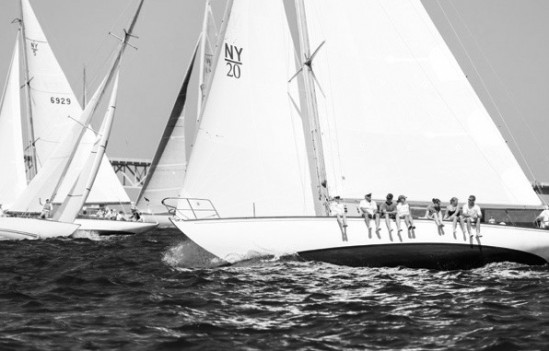
2015 DECEMBER CLASSIC SAILBOAT OF THE MONTH – Sparkman & Stephens SIREN
Type: NY-32
Siren Specifications:
LOA: 45’4″ / 13.81m
LWL: 32’0″ / 9.75m
Beam: 10’7″ / 3.22m
Draft: 6’6” / 1.98m
Design Number: 125
Designer: Sparkman & Stephens
Original Name: Folly
Current Owner: Peter Cassidy
Year Built: 1936
Built By: Nevins Yacht Yard Yacht Builders, City Island, NY
Contract Cost: $11,000
Hull Material: Philippine mahogany on white oak frames
Gross Displacement: 27,000 lbs
Ballast: 12,000 lbs
Sail Area: Original 950 sq ft
Sail Number: NY-20
Historical:
In 1935, when the New York Yacht Club was looking for boats to replace the 1905 “Thirties” designed by N.G. Herreshoff, their requirements included blue water seaworthiness in addition to grace and quickness. Olin Stephens and the Nevins Yacht Yard met the challenge, beating out competing designs by Alden and Nicholas Potter (the CAL 32). Twenty boats were built, with Olin Stephens specifying oak frames (1 5/8″ on 8″ centers), heavy Philippine mahogany planking, and a low, solid deck house, all without sacrificing speed or beauty. Originally priced at $11,000, the New York 32’s have stood the test of time, with about two-thirds of the original fleet still sailing.
In Olin Stephen’s words “We set out to design a good cruiser/racer with good all-around form, guided by the lines of Dorade, Stormy Weather and Edlu, and emphasized seaworthiness rather than around-the-mark agility.”
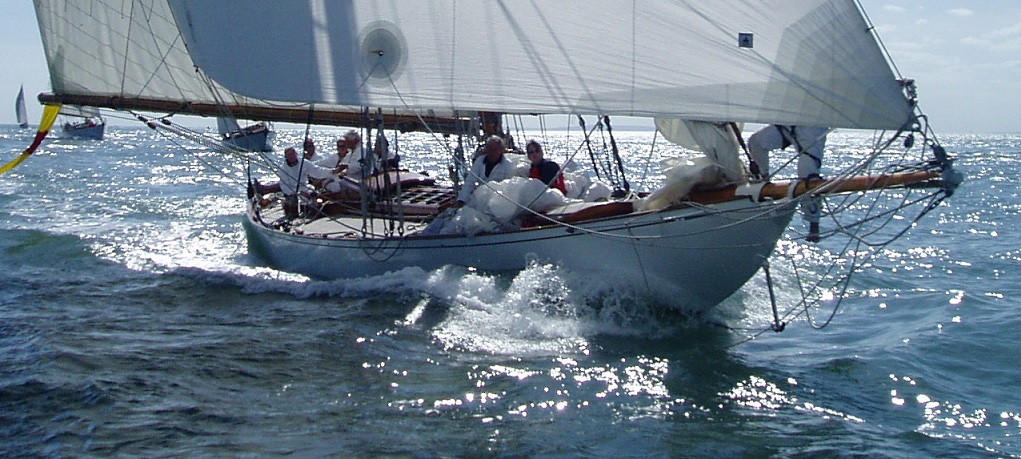
2015 NOVEMBER CLASSIC SAILBOAT OF THE MONTH – Alfred Mylne KELPIE
Mylne “Kelpie” Specifications
LOA: 63′ 6″ / 19.35m
LOD: 57′ 6″ / 17.52
LWL: 38′ 0″ / 11.58m
Beam: 11′ 6″ / 3.50m
Draft: 7′ 6″ / 2.28m
Displacement: 20,800kg
Identity No.: Y053790
Yard Number: 85
Hull material: Planked in pitch-pine fastened with iron dumps to grown oak frames at around 3’ centres and copper fastened to 2 heavy steam bent Rock Elm timbers between on an oak back-bone. The external lead keel is secured with bronze bolts. Iron strap floors on the grown oak frames.
Rig: Gaff Cutter
Designer: Alfred Mylne
Built by: J G Fay Co of Southampton
Year Built: 1903
Sail Number:
Historical:
KELPIE, the yacht’s name relates to a supernatural shape-shifting horse that haunts the rivers and streams of Scotland. Disenchantment with rule-makers is not the sole preserve of the modern era and at a time when the Linear Rater Rules were not entirely popular as they tried to grapple with dissatisfaction at length and Sail area rules. The main complaint was that the Linear Raters were too lightly built – designers and builders might have liked them but owners took a dim view!
KELPIE was designed by Alfred Mylne as a Solent 38 foot class to race with the 42 foot Linear Raters and the fact that she survives today is testament to how Mylne would have created a yacht when unconstrained by the rule. The story goes that owners who commissioned the new class decided to do so with a dinner honouring the passing of Queen Victoria.
With the introduction of the Meter rule in 1907, she was classed as a 12 Metre and raced with the 12s well into the 1920s.
In 1922 KELPIE was involved in the Erskine Childers’ plot to run guns into Ireland to use against the Irish Free State government. Childers was captured and executed but 600 carbines aboard KEPLIE were transferred to a fishing boat off Howth and she slipped away undetected.
KELPIE survived World War II with her keel intact – many yacht owners were encouraged to give up their lead keels for the war effort. After a string of South Coast owners she returned to the Dartmouth Yard of Nash & Holden where she benefited from 15 years of careful renewal and thorough maintenance ensuring her survival and present impressive condition.
Restoration:
Fairlie Restorations Ltd ( new wood keel, floors and lower frames, a new deck and deck structures to the original design; a new interior more sympathetic to the original intentions. extensive weight reduction exercise to the spars and rig. A new boom and gaff have been built by Nobel Spars and the yacht re-rigged by ‘Martins Rigging’* Current Name: Kelpie * Original Owner: * Current Owner: Pelham Olive
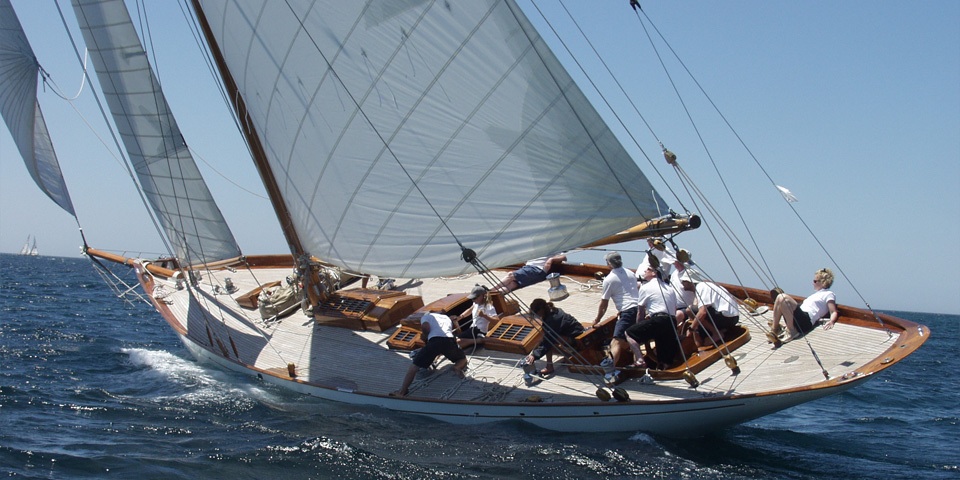
2015 OCTOBER CLASSIC SAILBOAT OF THE MONTH – William Fife III HALLOWE’EN
William Fife “Hallowe’en” Specifications:
LOA: 81′ 1″ / 24.7m
LOD: 71′ 2″ / 21.7m
LWL: 45′ 11″ / 14.0m
Beam: 14′ 9″ / 4.5m
Draft: 11′ 5″ / 3.5m
Original Rig: Bermudian Cutter
Construction: Wood
Engines: 80hp
Cruising Speed: 8 knots
Fuel consumption: 8 litres/per hour
Designer: William Fife
Original Owner: Lt Col JFN Baxendale
Built: 1926
Year Refit: 2008 Fairlie Restoration
Built By: William Fife & Son
Current Name: Halloween
Sail Area:
Sail Number:
Historical:
The 24.7m cutter Hallowe’en designed by William Fife III for Lt Col JFN Baxendale, was built to the 15m rule and launched in 1926 just in time to compete in the ORC FastNet. William Fife III, designer of a number of classic yachts still racing today was quoted once as saying “Hallowe’en is the perfect gentleman’s yacht. She is a jewel”.
William Fife decided to rig the yacht as a low-aspect ration bermudian cutter, which was uncommon in the days when gaff rigged racers dominated the various regattas. These experiments with her rig continued over the following years as her mast and boom heights changed and eventually she was transformed to a yawl.
After racing in the Mediterranean for a number of years she returned to the Atlantic under new owner Alfred Larsen, a Norwegian industrialist. She became the Royal Norwegian Racing Clubs official yacht and was helmed numerous times by future king to Norway, Prince Olaf.
In 1938 she ventured across the Atlantic and then disappeared off the radar. She was later discovered by Walter Wheeler and renamed Cotton Blosson IV before continuing her history of ocean racing and eventually being donated to the Classic Boat Museum at Newport, Rhode Island where she waited for a much needed refit. After 5 years of work in Newport, funds dried up and Hallowe’en was in need of new ownership and she eventually returned to the Mediterranean when Elizabeth Meyer (owner of J-Class Endeavour) helped find a buyer. She has had a number of refits (and owners) since then, the latest being completed in 2009 at Fairlie Restorations on the Hamble river, UK, and is now available for charter in the Mediterranean where she races competitively in the classic regatta circuit which stretches from France to Corsica, Spain and Italy.
Racing History:
FASTNET RECORD AUG 18th 1926 Racing in the 2nd Fastnet Race, Hallowe’en sailed the fleet home to cross the line some 10 hours before the next competitor. A record which would stand until 1939 when the new course was shortened, going out through the Needles Channel instead of heading around the east coast of the Isle of Wight, as had been the course since 1925.
Chartering:
Take a step back in time to 1926 when chartering the famous Hallowe’en. Complete with her original mahogany interior, Hallowe’en is one of the finest vintage racing yachts on the Mediterranean circuit. Hallowe’en is available for classic regattas (Trophée Panerai, Nice, Antibes , Régates Royales de Cannes, Palma Classic, Mahon Classic, les Voiles de Saint Tropez) and day charter with up to 10 people.
Enquire about chartering Halloween:
http://www.classic-charters.com/pages/yachts/charterEnquiry.asp?yachtUid=129
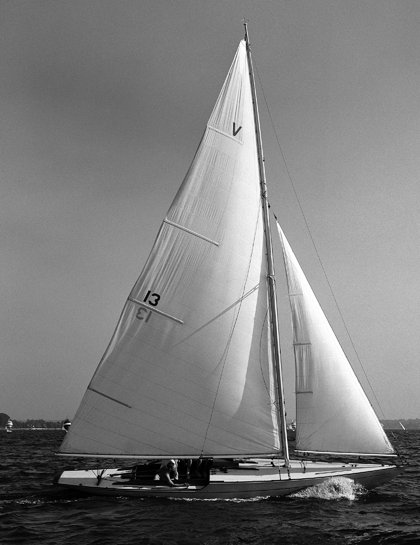
2015 SEPTEMBER CLASSIC SAILBOAT OF THE MONTH – William Gardner VICTORY CLASS
Type: Victory Class
Victory Class Specifications:
LOA: 31’8″ / 9.69m
LWL: 20’8″ / 6.33m
Beam: 7’0″ / 2.13m
Draft: 4’10” / 1.24m
Hull Number:
Designer: William Gardner
Original Owner:
Current Owner:
Year Built: 1920
Built By: Henry B. Nevins Shipyard, City Island N.Y
Hull Material: Wood
Gross Displacement:
Sail Number:
Rig: Marconi Rigged-Sloop
Historical:
Junius Spencer Morgan III, of West Island, Glen Cove, New York, the son of J. P. Morgan, the renowned financier, was instrumental in forming the Victory Class the year after World War I in the fall of 1919. Twenty yachtsman came forward through his efforts to build the vessel at Henry B. Nevins Shipyard in City Island N.Y. Launched in May of 1920, the raised fore-deck marconi rigged sloop proved to be a very fast dry capable yacht.
The class was formed to revive the sport of yachting after World War I with an affordable one-design class. They were named Victory-class in tribute to the yachtsmen who participated in World War I. Each boat was originally named after a phase of or reference to the war
Victory Class Sloop (Original 20)
*Ace – Adrian Iselin Jr (World War I flying aces)
A. E. F. E. G. – Potter
Alerte – Robert W. Martin (the sound of sirens during air raids)
Arethusa – C. D. Norton (HMS Arethusa was the name ship of her class of eight light cruisers built for the Royal Navy in the 1910s. She saw a considerable amount of action during the early years of the First World War, participating in the Battle of Heligoland Bight and the Battle of Dogger Bank.)
Black Jack – H. S. Morgan (John Joseph “Black Jack” Pershing (September 13, 1860 – July 15, 1948) was the general in the United States Army who led the American Expeditionary Forces to victory over Germany in World War I, 1917–18.)
Blue Devil – Howard Whitney (The 88th Infantry Division was a unit of the United States Army in World War I)
Blue Jacket – James B. Ford (The Bluejacket’s Manual is the basic handbook for United States Navy personnel.)
Bois de Belleau – F. R. Mayer (the battle of Belleau Wood, June 1918, the most important battle fought by US forces since the US Civil War.)
Buddy – Carroll B. Alker
Briquette – John T. Pratt (The compaction of loose combustible material for fuel making purposes, used commonly during World War I.)
Cantigny – Dr. C. I. Atkinson (The Battle of Cantigny, fought 28–31 May 1918, was the first American battle and offensive of World War I.
Carry On – Wm. H. Appleton
Gopher – F. W. Hine
Mary Rose – J. S. Morgan, Jr (HMS Mary Rose, launched on 8 October 1915, was an Admiralty M-class destroyer . sunk on 17 October 1917 approximately 70 miles east of Lerwick while escorting a convoy of 12 merchant ships from Norway.)
Mongolia – H. M. Curtis (December 29, 1911 the Mongols declared their independence from the collapsing Qing dynasty following the Xinhai Revolution.)
Naviator – F. Trubee Davison
Nieuport – R.A. Brown (French bi-plane fighter)
Otranto – R. B. Meyer (the 1917 Battle of the Strait of Otranto)
Soixante-Quinze – Swan & Stewart (field gun used in World War I by the American Expeditionary Forces, French for 75)
Spad – Harold I. Pratt (named in honor of a World War I bi-plane)
* Ace was originally built for Sherman Hoyt, but Mr. Hoyt was on board Vanitie, so was sold to Mr. Howard L. Curry for his son Gordon Curry
The Victory Class was governed by strict rules, Four persons allowed, but no paid hands. The boats were allowed to be hauled, but once in three-weeks, and not more than 48 hours. One suit of sails a season, and a detailed list of equipment must be carried, and no changes to lead ballast, and spar dimensions.
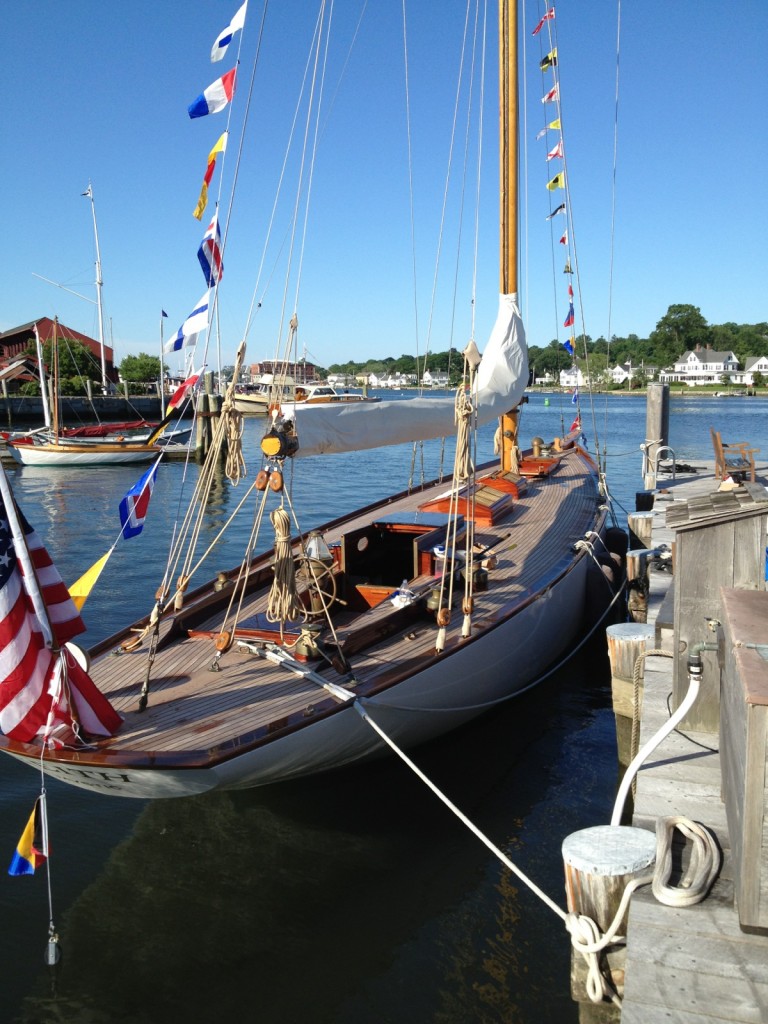
2015 AUGUST CLASSIC SAILBOAT OF THE MONTH – N.G. Herreshoff NEITH
Herreshoff “Neith” Specifications:
LOA: 61 ′ 0″ / 18.59m
LOD: 53′ 0″ / 16.15m
LWL: 40′ 0″ / 12.19m
Beam: 10′ 6″ / 3.20m
Draft: 8′ 0″ / 2.43m
Displacement: 41,000 lbs
Sail Area: 1,400 sq ft
Yard Number: 665
Hull Material: Original Double Planked Topsides – Cypress over Yellow Pine on Red Oak – Current Mahogany on White Oak
Original Rig: Gaff Cutter
Designer: N.G. Herreshoff
Built by: Herreshoff Manufacturing Company, Bristol, RI
Year Built: 1907
Original Owner: Dr. Ed Dunham
Status: Active
Contract Price: $9,000
Sail Number: 123
Historical:
Neith, named after the Egyptian Goddess of the Hunt, was intended as a gentleman’s weekender for N.G. Herreshoff’s personal doctor.
Sold to her third owner Neith attempted to sail to England in 1920, but was forced to sail back after encountering Hurricane force winds. A year later, now as a yawl, Neith attempted the crossing again, this time successfully.
Spending much of her life abroad Neith cruised and raced throughout Scotland and Europe, where she proved slow with her new stubby yawl rig. By 1926, Charles E. Nicholson convinced the owner to try the new Marconi rig. The experiment proved successful, and as testament to the brilliance of Nicholson, still stands rigged as a Marconi to this day.
As the story is told, one Scottish owner, as a tribute to Neith’s heritage with much fanfare kept a bronze statue of the Egyptian Goddess of the Hunt on the hearth of his home. Each time through her commissioning and decommissioning, the owner’s party celebrated through the sounds of bagpipes, as the statue was moved to and from the yachts hold.
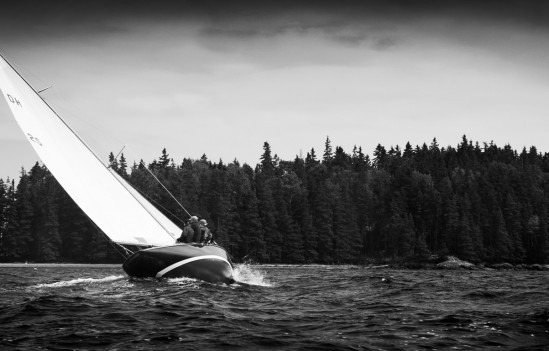
2015 JULY CLASSIC SAILBOAT OF THE MONTH – Sparkman & Stephens DARK HARBOR 20
Dark Harbor 20″ Recreation
Sparkman & Stephens of New York, the 75-year-old yacht design firm, is proud to announce the reintroduction of the Dark Harbor 20, the 30-foot one-design class sloop, which is to be constructed for the first time in modern fiberglass materials on a production basis at a very reasonable cost.
LOA 30′-0″ 9.14 m
LWL 20′-0″ 6.10 m
BMAX 6′- 8-1/2″ 2.06 m
Draft 4′-1-1/4″ 1.24 m
Displacement (Lightship) 5,200 lbs 3,360 kg
Ballast 2,620 lbs 1,190 kg
Sail Area (100% fore triangle) 357 ft2 33 m2
Design No. 68
History And Design
In 1932 a committee composed of members of local yacht clubs around Long Island Sound was formed, including members from Seawanhaka, Larchmont and American Yacht Clubs. Their task was to develop a new class of racing sailboat to compete with the Sound Interclub and Atlantic classes. One of the proposals was from Sparkman & Stephens, A Proposed New One- Design Class for Long Island Sound. Hull number one was named Gimcrack, a 34′-6″ LOA, 23’LWL low-profile day sailer very similar in appearance to the Dark Harbor 20. Olin Stephens and the Davidson Laboratory at Stevens Institute successfully used Gimcrack to correlate scale model results with full-scale sailing testing, measuring the longitudinal driving force, aerodynamic side force and heeling moment. The correlation constants between model testing and full-scale performance as derived by these studies became known as the Gimcrack Coefficients. The Gimcrack Coefficients were the first known comparison of this type, proving to be a significant breakthrough in the science of sailing yacht performance prediction. This early trial horse became the genesis of the design of the Dark Harbor 20. In 1934, Olin Stephens took the results from the Gimcrack testing and designed the Dark Harbor 20. She was designed as a fairly fine ended and easily driven hull form, with a simple and straightforward rig. Twenty-one Dark Harbor 20 were built in the first half of the 20th century. Due to the dedication of their owners and the members of the Tarratine Yacht Club of Dark Harbor (Islesboro, Maine), most all of the original DH20’s still exist today and actively compete in the pristine waters of coastal Maine. In a combined effort between the members of the Tarratine Club, Sparkman & Stephens, and Shaw Yacht of Thomaston, Maine, new DH20’s are to be built starting this summer in fiberglass.
Conformity To Originals
In preparation for the design of the fiberglass version of the Dark Harbor 20, Sparkman & Stephens inspected and documented a sampling of the existing Dark Harbor 20 fleet to ascertain the stability and verify the as-built weights of the existing vessels. A series of Dark Harbor 20s were subjected to freeboard measurements (which, when used with the hull lines, can be used to determine the vessel’s weight and longitudinal center of buoyancy), in-the-water inclining experiments (a procedure used to incrementally heel a boat to both port and starboard to access its stability and vertical center of gravity), and on-land scale measurements (to confirm the weight ascertained from freeboard measurements). The fiberglass models have been designed to match the weight and stability of the original fleet so that new boats can race with the existing fleet on an equal basis, preserving the competitive nature of this esteemed one design fleet.
Construction
Shaw Yacht of Thomaston, Maine has been selected as the authorized builder of the new fiberglass Dark Harbor 20s. The production-quality molds of the hull, deck, keel, and rudder are created directly from Sparkman & Stephens 3-dimensional surface models for a high degree of accuracy to the original plans.
The hull, deck, deckhouse, and cockpit are to be built of hand-laid fiberglass over a foam core. The rudder and deadwood will also be built of fiberglass, with the cores of each being poured foam with an adjustable density to accurately match the weights of their original wooden counterparts.
The boats will be finished in gelcoat for a durable, low maintenance finish, with a color of the owner’s choice. The deck surface will have a durable canvas non-skid pattern akin to the originals, achieved by having a permanent texture added to the deck molds. To retain the aesthetics of the original boats, the new boats will have a tasteful amount of wood trim. Woods available will be either teak or mahogany, and either oiled or varnished. The deckhouse and cockpit seating will have vacuum-bagged wooden veneers while the cockpit coamings and toe rails will be solid wood. The spars will be constructed directly from the original plans, and be built of high grade, clear Sitka spruce.
Pricing
Please contact Harry Morgan at Sparkman & Stephens for current pricing and availability.
529 Fifth Avenue, New York NY 10017
(212) 661-6170, fax (212) 661-1235
Email: hmorgan@sparkmanstephens.com
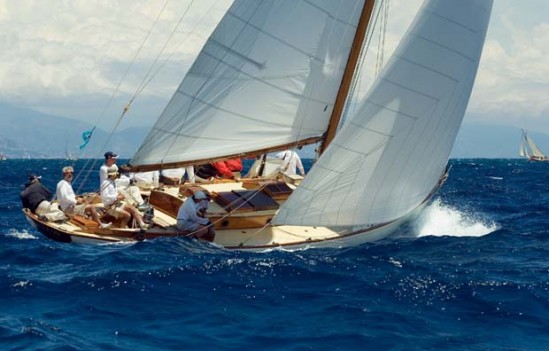
2015 JUNE CLASSIC SAILBOAT OF THE MONTH – Sparkman & Stephens SIRIUS
Type: NY 32
ex, Away, ex Dolphin
S&S SIRIUS Specifications:
LOA: 45′ 4″ / 13.8m – LWL: 32′ 0″ / 9.75m – Beam: 10′ 7″ / 3.22m – Draft: 6′ 6″ / 1.98m – Design Number: – Rig: Sloop – Displacement: 40,000 lbs – Sail Area: 1,332 sq ft – Designer: Sparkman & Stephens – Built By: Henry Nevins, City Island N.Y. – Original Owner: Henry Sturgis Morgan – Current Owner: Paolo Zannoni – Launched: 1936 – Sail Number: NY 19
Historical:
To replace the NY 30, in 1936 New York Yacht Club Commodore W.A.W. Stewart organized a competition for the design and construction of the Club’s new boat, calling the best naval architects: John Alder, Luders, Ford & Paine, W J Roue, Belkar & Paine and Sparkman & Stephens. The instructions were a waterline no less than 30 feet, accommodation for 4 guests and one crew and the Scantling Rules of Lloyds. Olin Stephens was chosen and Henry B. Nevins Shipyard of City Island offered to deliver all the boats within 1 year – on completion of the 20 boats the tooling was destroyed as established by the NYYC. According to the magazine, The Rudder, “ ….the club did not want a crowd on the starting line and, above all, if the class were enlarged, the boats could end up in undesirable hands.”
NY 19 was built for Henry Sturgis Morgan, founder of Morgan Stanley. He was a prominent yachtsman, Commodore of the NYYC and Chairman of the America’s Cup committee.
Known Racing History: ?
Known Restoration History:
2013-2014 – Cantiere Navale dell’Argentario
– New rudder
– Stripping the hull back, re caulking and fairing
– New sea cocks and skin fittings
– Full Awlgrip paint treatment
– New engine, transmission and ancillaries fitted under close supervision of S&S New York
– New fuel and water tanks
– New electrical systems, batteries etc
– New instruments
– Stripping bright work back to bare wood and full 12 coat varnish system
– Application non slip to deck and coach roof
2006 – Cantiere Navale dell’Argentario –
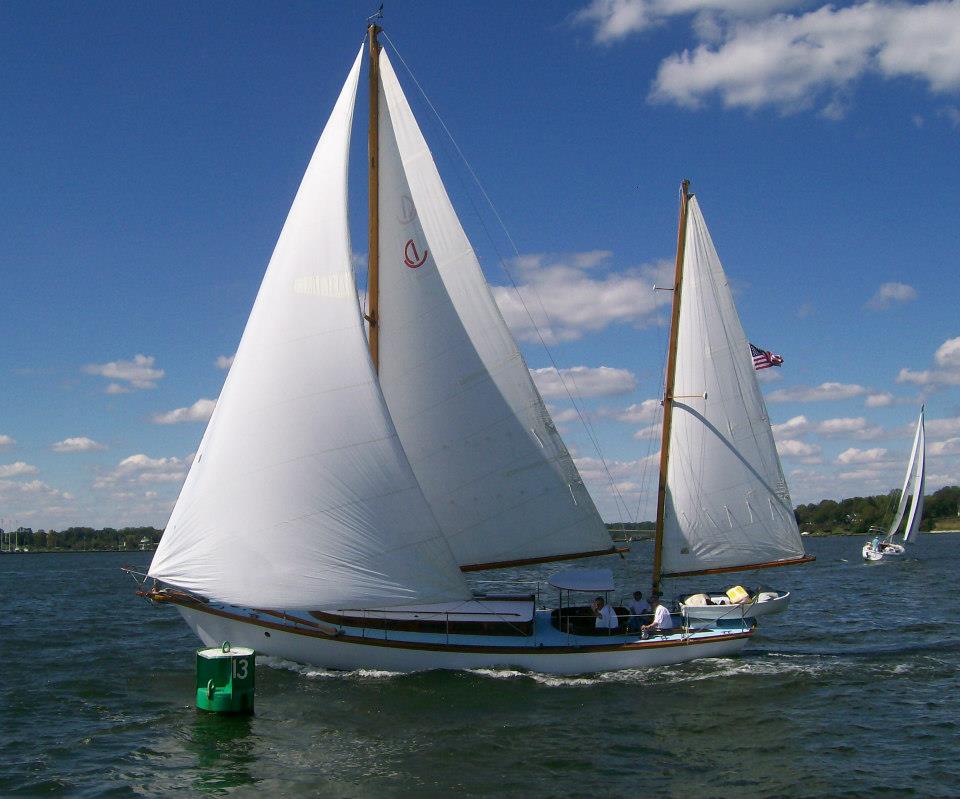
2015 MAY CLASSIC SAILBOAT OF THE MONTH – Edmund A. Cutts SPELLBOUND
LOA: 47’0″ / 14.32m – LOD: 44’0″ / 13.41m 0 LWL: 37’0″ / 11.27m – Beam 10’10” / 3.07m – Draft 3’9” / 1.18m (centerboard) – Hull Number: – Designer: Edmund A. Cutts – Original Owner: Abe Oberlin, New York, N.Y. – Current Owner: Cutts and Case, Inc – Year Launched: 1970 – Built By: Cutts and Case, Oxford, MD – Hull Material: Vertically framed, bronze strapped – Gross Displacement: – Sail Number: – Documentation Number: 550570
Edmund A. Cutts, friend and disciple of L.Francis Herreshoff, designed and built SPELLBOUND for Abe Oberlin of New York City.
Edmund A. Cutts, a self taught designer like the Herreshoffs and Stephens, and innovator of the Cutts method of yacht construction, built SPELLBOUND with no wooden keel. the centerboard casing is constructed out of bronze, resting on a gasket on top of the lead ballast. Vertically framed with bronze strapping brought well up from the garboards.
The resulting design is beautiful and timeless, and was featured in director Tom Dey’s 2006 Paramount Pictures movie FAILURE TO LAUNCH.

2015 APRIL CLASSIC SAILBOAT OF THE MONTH – Philip L. Rhodes “Escapade”
LOA: 72′ 06″ – LWL: 54′ 00″ – Beam: 17′ 00″ – Draft: 7′ 10″ (Board up) 14’0″ (Board down) – Displacement: 110,00 lbs – Sail Area: 2,630 sq ft – Ballast 2,400 lbs – Designer: Philip L. Rhodes – Built by: Luders Construction Company, Stamford CT – Year Built: 1937 – Original Owner: Henry G. Fownes – Contract Price: $40,000.00
“Queen of the Great Lakes” – ESCAPADE was designed by Philip L. Rhodes, MIT graduate in naval architecture and engineering. She was constructed by the Luders Construction Company of Stamford CT at the end of the great depression in 1937, and was launched with great fanfare on May 25th, 1938.
ESCAPADE was designed for Henry G. Fownes, of Stamford, Connecticut, who wanted the largest boat that could fit under the size limit for the Bermuda Race, but shallow drafted enough to travel down the Intracoastal Waterway. A beamy shallow-drafted yacht with a towering rig.
Ownership History:
1965 – Peter W. Grimm, Ft. Lauderdale FL
1959 – 1965 – Baldwin M. Baldwin – Pasadena, CA
1956 – 1959 – James Y. Camp – Bakersfield, CA
1947 – 1954 – Wendall Anderson -Great Lakes
1938 – 1947 – Henry G. Fownes – Stamford, CT
Racing History:
1980 – Opera House Cup – Overall Winner
1976 – Opera House Cup – Overall Winner
1967 – Bayview-Mackinac – Fifth Time Overall Winner!
1967 – Royono Trophy
1960 – Bermuda to Sweden Race – 3,500 miles Winner 17 finishers
1960 – Miami to Montego Bay – Winner
1954 – Bayview-Mackinac – Overall Winner
1954 – Royono Trophy
1954 – Miami-Nassau – Line Honors
1953 – Bayview-Mackinac – Overall Winner
1952 – Miami-Nassau – Line Honors
1951 – Rochester Cup (Lake Ontario) 377-mile Overall Winner
1951 – Chicago-Mackinac – Winner
1951 – Bayview-Mackinac – Overall Winner
1951 – Toledo Yacht Club Mills Cup – Overall Winner
1950 – Bayview-Mackinac – Overall Winner – 25:47:19 Old Course Record
1950 – Royono Trophy
1950 – Miami-Nassau – Line Honors
1949 – Bayview-Mackinac – Line Honors
1941 – Miami-Nassau – Line Honors

2015 MARCH CLASSIC SAILBOAT OF THE MONTH – L.F. Herreshoff “Ben My Chree”
Herreshoff “Ben My Chree” Specifications:
LOA: 28’0″ – LWL: 22’10” – Beam: 6’11” – Draft 2’9″ – 5’6″ – Displacement: 4,000 lbs – Sail Area: 265 sq ft – Ballast 2,400 lbs – Designer: L. Francis Herreshoff
“L. Francis Herreshoff designed this stunning boat in 1932 for Mr. Willoughby Stuart. Her plans are entitled 28′ Knockabout – Design No. 53. Mr. Stuart’s boat was built in 1933 and named BEN MY CHREE*, Gaelic for “darling of my heart”, BEN for short. He took her to his island home on Penobscot Bay, built a boathouse and railway for her, and she remained in the area for over 40 years, enjoyed by him and his family.”
In 2013, 80 years after her completion, Ballentine’s Boat Shop fully restored her. It took two years but she is as lovely as ever and should live to see another 80 years. Great care was taken to restore her to her original specs and L. Francis Herreshoff’s plans.

015 FEBRUARY CLASSIC SAILBOAT OF THE MONTH -Knud Reimers “Vixen”
Reimers “Vixen” Specifications:
Class Type: 15 Square Metre – LOA: 33″ 0″ / 10.05m * LWL: 21′ 8″ / 6.64m * Displacement: 1.3 Tonnes * Year Built: 1937 * Built By: Oscar Schelin Kungsors Boat Yard, Sweden * Restore By: 2011 Brooklin Boat Yard
Brooklin Boatyard had the following to say about the restoration of Vixen
Vixen was designed by Knud Reimers and built at the Kungsors boatyard in central Sweden by Oscar Schelin. Imported to the UK before the Second World War, she was one of only a handful of the elegant Square Meter Rule yachts. At the time building to the rule was prolific in the Baltic but scarcely known in the UK. As co-skipper Jack Gifford explains, “Much finer in form and lighter in displacement than her British counterparts, Vixen and her kind were viewed with suspicion by the (British) yachting establishment and with her light and efficient construction deemed as ‘un-seaworthy.” One famous British sailor had fallen in love with the Swedish Square Meter yachts and collaborated with Reimers to build his own yacht. That, of course, was Uffa Fox, and the boat he built at Cowes was the Vigilant. So confident was Uffa in its sea keeping that he set out to sail it to its spiritual homeland of Sweden to take part in the Swedish championships.
Vixen was purchased sight unseen by a client who had already had a very successful restoration experience with Brooklin Boat Yard that being the total restoration of Katrinka. While not always advisable to purchase a boat without even seeing it the client figured Vixen had to be in at least OK shape (she’s just sailed the North and Baltic Seas) so Vixen was packed into a shipping container and arrived at Brooklin Boat Yard in late July of 2011. While she was in good enough shape to sail that year’s Eggemoggin Reach Regatta it was clear that quite a bit of restoration work was needed.
Once Vixen’s restoration was competed approximately 75% of her frames and floors and 50% of her hull planking had been replaced along with a new deck, cockpit, cabin house and all new deck hardware.
Vixen now lives in Brooklin but she travels quite a bit (by land) to compete in as many of the classic yacht regattas as she can.
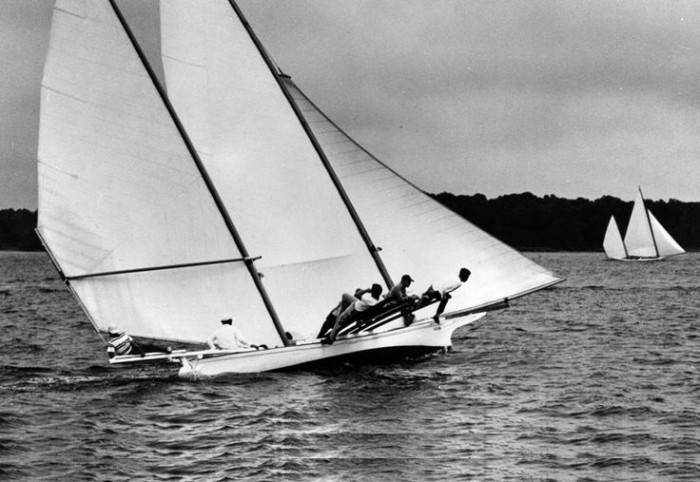
2015 JANUARY CLASSIC SAILBOAT OF THE MONTH – William Sidney Covington “Island Blossom”
Historical:
Island Blossom is one of the last 22 surviving traditional Chesapeake Bay racing log canoes that carry on a tradition of racing on the Eastern Shore of Maryland . These vessels are of great historic significance because they are the sole active survivors of a vessel type indigenous to the Chesapeake region from the earliest days of its settlement
The Olde and New Worlds.
The aboriginal dugout canoe, so essential to life on the Chesapeake Bay for travel, harvest and trade, were the forefathers that were led to its adoption by 17th century European colonists using imported tools and technology.
Increasing world demand for the Chesapeake’s bounty of tobacco, fish and oysters led to a need for larger and faster work boats. By the mid-1800s, the addition of a keel, a tiny cabin,and side decks to a five-log hull resulted in a brogan,which moved this work boat beyond the definition of canoe.
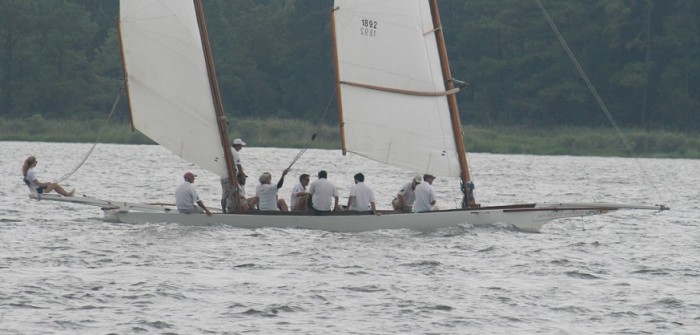
The race was on to develop the swiftest sailing vessels. Over 6,300 sailing canoes were working the shores of the bay by the 1880s
“They were your family pickup truck”
William Sidney Covington, was the builder of the famed “Island” group of log canoes–the Island Bird, Island Bride, Island Belle, Island Beauty, and Island Blossom.
Island Blossom along with Island Bird are the only members of the original five-canoe group to survive. The Blossom was constructed to the order of William H. Myers, Sr. of Oxford who had her logs cut from a tract of woodland near Trappe and floated to Tilghman Island.
In the 1920s Island Blossom was sold to Stanley Evans of Elkton who only occasionally raced her. In 1952 she was purchased by John C. North, great grandson of the original builder, and brought back to Talbot County. Her hull was in good condition but she needed new spars and sails.
Between seasons the log canoes were raced along the shores of St. Michaels, Oxford, Cambridge, and many other shore towns. The races were highly publicized, often 50 boats would gather at the starting lines. It wasn’t unusual to see 5,000 spectators gather to see the races. The rules of racing were based on the over-all length of the boat. There were no limits on the amount of sail or crew each boat carried. Unballasted, some of the boats, when the mast were stepped, had at least a half a dozen men in the boats to prevent capsizing.
In the day it was the Eastern Shore against the Western Shore, Island Blossom versus the William V. Wilson. Island Blossom capsized during the race, relinquishing a mile lead to the Wilson before Blossom would be sailing again, but with her speed the Blossom would go on to win the race. It was said that a great many dollars changed hands after the race was over!
Island Blossom has won the Governor’s Cup and Covington trophies many times in the course of her racing career. Today she is sailed by Corbin Penwell. Corbin has sailed her to the season championship 4 times and if he does it again this year, it would be a record (and retire the trophy).The sails are cut by John Jenkins of Jenkins Sails. and John currently builds the sails for most of the fleet.
William Sidney Covington “Island Blossom” Specifications:
“Length and Width is all that Matters”
LOA: 32′ 7″ / 9.75m * Beam: 6′ 7″ / 2.04m * Draft: * Ballast: No Ballast * Displacement: * Sail Area: * Hull material: * Rig: * Built by: William Sidney Covington, Tilghmans Island, MD * Year Launched: 1892 * Restored By: * Current Name: Island Blossom * Original Owner: William H. Myers, Sr * Current Owner: North Family Trust * Sail Number: 9

2014 DECEMBER CLASSIC SAILBOAT OF THE MONTH – Robert Logan “Rawhiti”
Historical:
Royal New Zealand Yacht Squadron, Commodore C. P. Murdoch presented to Mr. Pittar, upon the launching ceremonies, the club’s burgee, and noting through his adjournment, at a champagne luncheon, a toast of” The Owner” saying that Mr. Pittar had done more than any other man in the colony to uphold New Zealand yachting, and the reputation of Auckland-built yachts in New Zealand and Australia, sparing neither money nor time in the interest of the sport.
The new yacht “Rawhiti,” soon after her launching was sailed to Sydney, under the charge of Capt O. Schulze, a well-known trader to the islands, Mr. John Bell, a well-known Auckland yachtsman who rigged the yacht, and Mr. F. Bennett, a young man with good sea going experience, and of which the following reflects his experience.
At 4 pm on the 18th day of October 1905 the yacht “Rawhiti” weighed anchor in Waitemata harbour to commence a voyage of 1,280 miles / 2,059.96 kilometer across the Tasman Sea. A succession of circular gales and storms accompanied by high seas and head winds ensued during the stormy 28-day, 10 hour passage. Hove to for nearly 120 hours, and broaching once at midnight on October 31. under a double-reefed trysail and staysail, the little ship weathered it all, “a perfect marvel,” exceptionally seaworthy, testament to her skillful designers and builders.
Rationing of provisions began on the 9th of November on four biscuits a day. The crew discussed the advisability of putting in to Lord Howe Island to re-provision, but unfavourable winds prevented changing course. These rations continued until 1:16am on November 15th when land was sighted, with no more short rations left, a leading breeze allowed entry into Port Jackson and ending a long weary voyage across the Tasman Sea.
1940s – S W Marler, a New Zealand businessman, acquired the vessel (1945-1969), after an extensive refit, brought her back to New Zealand, with a stipulation that she would never race in Sydney again. Raced in New Zealand under the Royal New Zealand Yacht Squadron for over 20-years
1960s – Don Brooke acquired the yacht, modernizing her rudder and rig and added a above-deck cabin.
After Brookes’ ownership, through numerous changes in owners, sat deteriorating in Manukau Harbour
1990s – Wayne Hurst, a boat painter acquired her and completed an extensive restoration. In 1994 she was acquired by Brent and Rebecca Belemi, who raced her with the Classic Yacht Association.
2005-2011 – Greg Lee commences a six-year restoration of the century, lead by master shipwright Peter Brookes, Waimauku, NZ of Brooks Boatbuilders.
Robert Logan “Rawhiti” Specifications:
LOA: 54′ 0″ / 16.5m * LOD: * LWL: 34.9′ / 10.6m* Beam: 9.8′ / 2.98 * Draft: 7′ 0″ / 2.13M * Ballast: * Displacement: 6.5 Tons * Sail Area Upwind: * Yard Number: * Hull material: Over Built For Passage Making, Diagonal Principle, Triple-Skin Kauri, All Boards Being the Full Length of the Hull * Rig: Gaff Rigged Cutter * Mast: Oregon Pine * Other Spars: Spruce * Designer: Robert Logan Snr * Built by: Messrs. Logan Bros., Auckland, Mechanics Bay (now filled in), New Zealand * Year Launched: 6th October 1905 * Christened By: Mrs A. Logan * Restored By: Brookes Boatbuilders of Waimauku * Current Name: Rawhiti (“Sunshine”) * Original Owner: Mr. A T Pittar, Sydney * Current Owner: Greg Lee and Sam Stubbs (brothers in law) * Sail Number: 6
Known Restoration History:
2005 – 2011 – Brookes Boatbuilders
Known Racing History:
30-Year Port Jackson Champion
2014 NOVEMBER CLASSIC SAILBOAT OF THE MONTH – C. Raymond Hunt “The Lawley Two-Twenty-Five”
In 1936 Raymond Hunt along with engineers Bror Tamm and Gordon Munro decided to build a 36’0″ prototype at the Lawley Yard in Neponset, Masachusetts. Although there were doubts about her potential sailing abilities, she quickly proved doubters wrong. But, at the time, no one seemed to like the prototype, she was too peculiar, and slab-sided for her size.
After much thought and consideration the Raymond Hunt brain trust decided to scale down the 36′ prototype twelve feet. The new yacht was called at first the Lawley 110 then the National 110 and eventually the International 110, which became the forebearer to Raymond Hunt’s 10 series of Yachts.
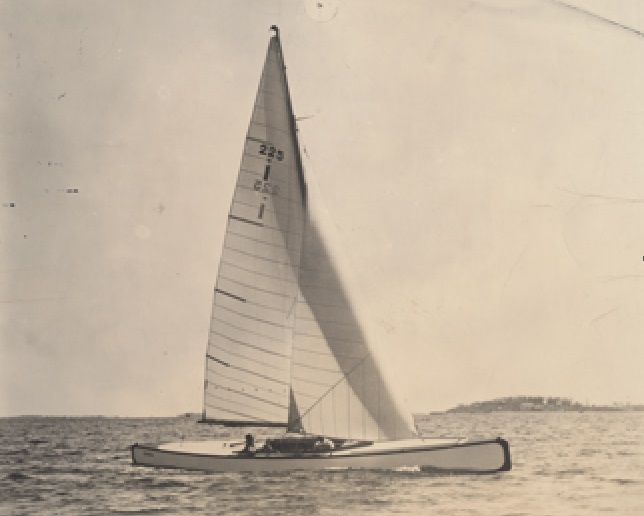
In 1939 The Corinthian Yacht Club members, of Marblehead, Massachusetts, were looking for a spirited one-design club boat for Massachusetts Bay, having searched for a low cost, low maintenance solution they decided on and sponsored the Lawley 225. Further evolved and improved by C. Raymond Hunt and Frank C. Paine, “Egeria” was the first of the 225 class boats, known as 225/1. “Egeria” proved to be very fast, beating most of the class boats in Marblehead except the 30-Square-Metres.
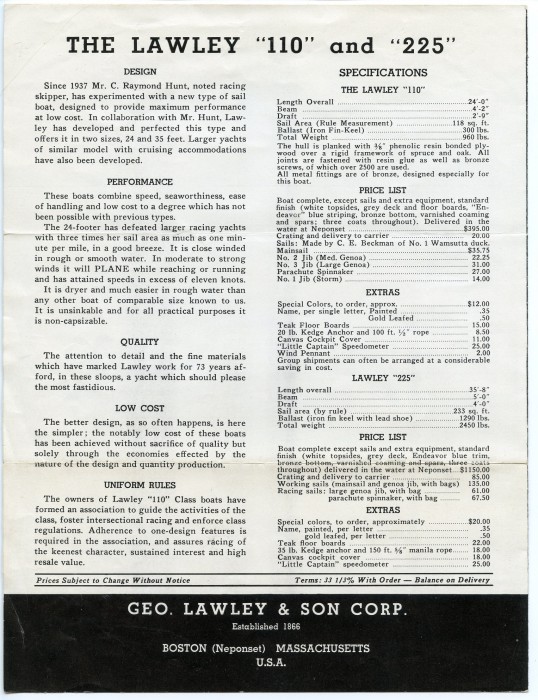
In 1940, when most yards were at capacity producing war effort ships, Lawley’s, decided to enter into a sales contract with the Cape Cod Shipbuilding Company of Wareham, Massachusetts, whereby CCS purchased the entire building rights to the line of small sailboats developed prior to the start of World War II. This agreement allowed current owners a continuous flow of replacement parts, and for Lawley’s pre-war brand to be constructed without delay The pre-war list included the Lawley 110, now known as the International 110, the Lawley 225, the Lawley 15′ sloop, and the Lawley 8′ pram.
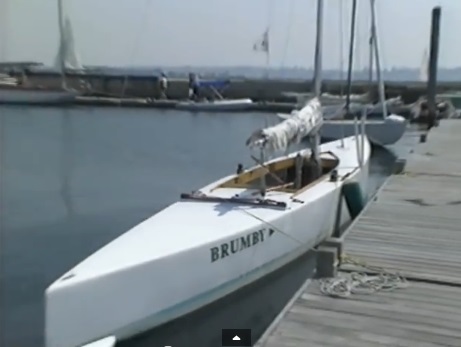
Hunt “Lawley 225″ Class Specifications:
LOA: 35’8″ / 10.85m * LOD: 35’8″ / 10.85m * LWL: 26′ 0″ * Beam: 5’0” / 1.55m * Draft: 4′ 0 / 1.21m * Ballast: 1,295 lbs * Displacement: 2,450 lbs* Original Sail Area: 225 * Sail Area By Rule: 233 sq ft * Yard Number: Prototype * Hull material: Weldwood Construction * Rig: Sloop * Designer: C. Raymond Hunt * Built by: George Lawley & Son, Neponset, Massachusetts * Year First Built: 1936 * Contract Cost: $1,150 w/o sails
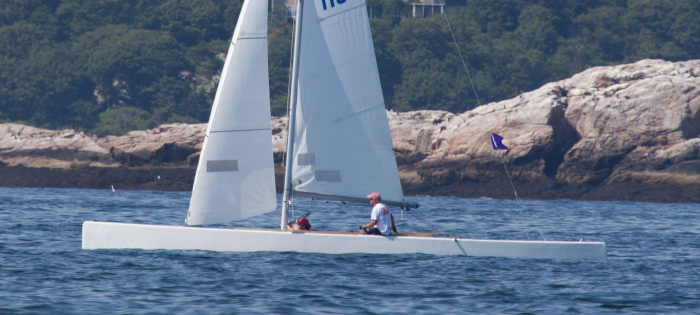
Past Ownership (Class) History:
1.) Lawley 225 Class – (Egeria) sail number 225/1
2.) Lawley 225 Class – (Briggs Cunningham- Top 6-metre sailor)
3.) Lawley 225 Class – (Brumby Tom Callahan) – (Brumby Museum of Yachting, Donated by Mr. Callahan) – (Jaws ?) – (Dagger Ted Boynton)
*Three class boats that we know about (so far)
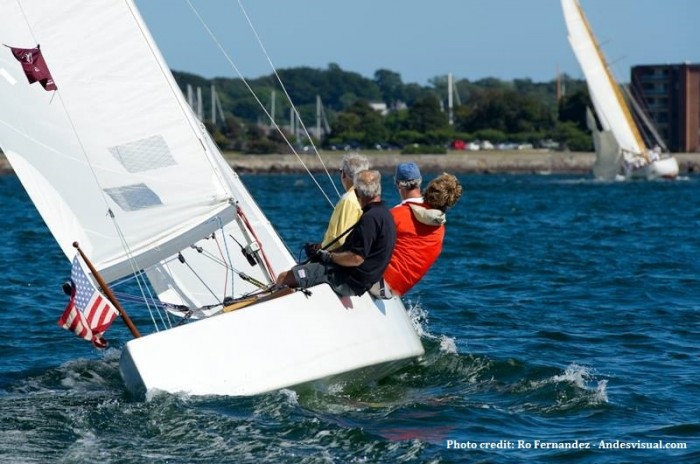
Known Racing History:
2014 – MoY Classic Yacht Regatta Class Grand Prix Winner (Dagger), skippered by Ted Boynton
1993 – MoY Classic Yacht Regatta Class D Winner (Brumby), skippered by Tom Callahan
Known Restoration History:
Historical:
Dagger is the last remaining, in sailing form, Lawley 225 in existence. A second existing hull was reported to be in the Midwest and is currently being used as a flower box.
Jaws – Dagger – Previous owner used a J-24 rig, current owner sails with an Etchell’s rig
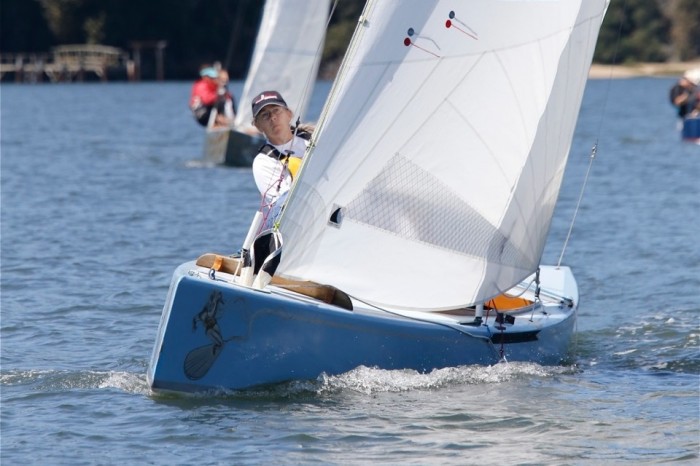
2014 OCTOBER CLASSIC SAILBOAT OF THE MONTH – C. Raymond Hunt International “ONE-TEN”
In 1936 Raymond Hunt along with engineers Bror Tamm and Gordon Munro decided to build a 36’0″ prototype at the Lawley Yard in Neponset, Masachusetts. Although there were doubts about her potential sailing abilities, she quickly proved doubters wrong. But, at the time, no one seemed to want one, the prototype was too peculiar, and slab-sided for her size.
After much thought and consideration the Raymond Hunt brain trust decided to scale down the 36′ prototype twelve feet. The new yacht was called the International 110, and with it a new era in yachting was ushered in.
By the late 1930s yacht construction prices were skyrocketing. Through Hunt’s association with Lawley’s in the mid to late 30s, Raymond began experimenting with a new boat building material Harborite Plywood. The miracle overlayed fir plywood, offered “Armor Plate” protection with two tough, abrasion resistant surfaces of plastic resin impregnated fibres that are permanently welded together, creating a seamless easy, and cost effective way to build a boat. The 110 was built with four 12 foot sheets of Harborite laid over laminated oak frames and would use a simple rig with a rated sail area of 110 square feet, hence the name.
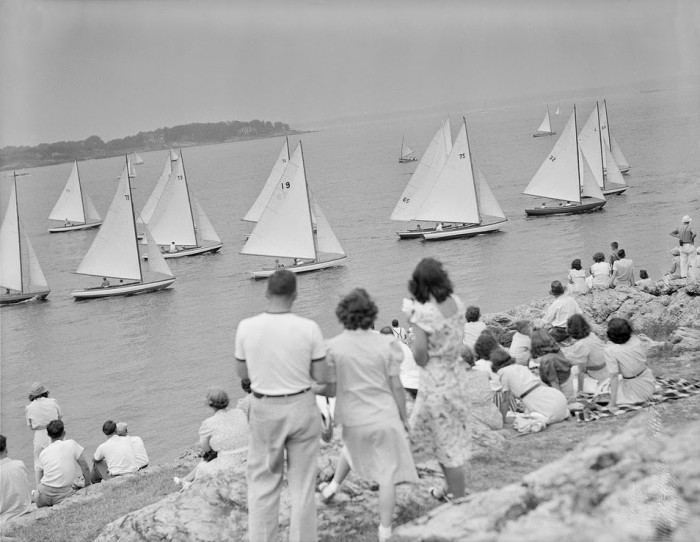
The International 110 was introduced at the 1939 Marblehead Race Week Regatta. Ray Hunt raced the boat around the coarse beating everyone boat for boat except the International One Design. With a price of $480.50 with sails the demand for this vessel began in earnest.
Ray Hunt would forever change the sailing world, hundreds of his new 110 design were being delivered as fast as they could build them. Unheard of for the time period, where other ship yards at best were producing 6-8 yachts a year, there were over 400 hulls built in a two year time period. Today as true testament to Hunt’s abilities, the 110 is still in production, and recently the class celebrated its 75th anniversary in Marblehead, Massachusetts, the place where things all began in those depression years prior to World War II.
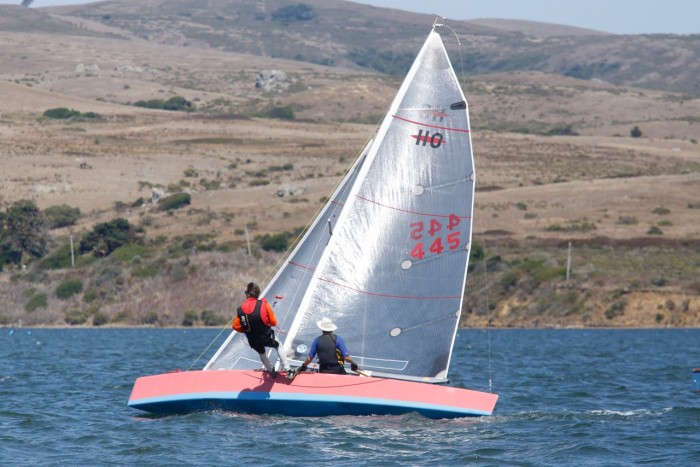
Other innovations that were created through the nimbleness and speed of the 110 was the creation of a trapeze system. A simple wire and harnessing system that allowed crew weight to extend outboard. The one ten was iconic in the harbors there were used in, ultimately claiming namesake to today’s ultralight sport boat concept.
Through the initial aesthetic development of the 110, it was believed that painting the hull in such a way that would accentuate the roundness of the edges was absolutely necessary, if the shape of the hull is to look well. The new painting schedule was encouraged, but was often overlooked, in favor of more budget friendly all in one color paint scheme.
The Internation 110 is still in production, the current builder is Westease Yacht Service, Inc., 66th St & 135th Ave N, Saugatuck, MI 49453, Phone: (616) 394-0076. There are active racing fleets across the US in Maine, Massachusetts, Rhode Island, Connecticut, New Jersey, Illinois, Michigan, California and Hawaii.
International 110 Specifications:
LOA: 24’0” / 7.3m
LWL: 18’0″ / 5.5m
Beam: 4’0” / 1.2m
Draft: 3’0” / 0.91m
Displacement: 910 lbs
Ballast: 300 lbs
Designed: C. Raymond Hunt
Hull material: “Harborite” Plywood Construction
Original Contract Cost: $480.50
Sail Plan: Main, Jib, Spin
Spinnaker: Conventional
Upwind sail area: 157 sq ft
Spinnaker sail area: 100 sq ft
Mast Height: 23’0″
Crew: 2
In production: Yes
Class Website: International 110 Class
Approximate number built: 750+
2014 SEPTEMBER CLASSIC SAILBOAT OF THE MONTH: George Owen P-Class Yacht “Bernice”
The Hodgdon yard of East Boothbay, Maine launched the 55-foot “P-class” gaff-rigged sloop in 1916. BERNICE was designed by George Owen, a contemporary of Nathaniel Herreshoff. L. Francis Herreshoff once said “George Owen’s yachts could even be said to be beautiful, and this adjective could only be truthfully applied to a few things in this world.”
Owen was known for producing consistently excellent racing yachts, and for his work developing rating systems. BERNICE is considered to be the last remaining Owen designed P-class boat. She sailed only a few years in the salt water of the east coast before moving to the Great Lakes. In the late 1920s or early 1930s she was re-rigged to a fractional marconi yawl and an engine was installed to facilitate cruising.
When Bernice arrived in Rockport for restoration, after spending much of her life in the fresh waters of the Great Lakes, the boat was in need of major work. All but four pairs of frames were replaced, and much of the planking as well. The boat is double-planked: outer layer is mahogany and the original inner planks are of cypress; any new planks are in western red cedar. To support the boat during this extensive rebuild, Rockport Marine created a support system that was bolted into the shop’s walls and ceiling.
As a racer, Bernice had a very spare interior, but Brendan Riordan, Rockport Marine’s designer, created a new arrangement plan to accommodate a family of four on weekend cruises and utilize the space available as fully as possible. There’s a master cabin aft, two berths amidships, and two pipe berths in the forepeak. The small galley has pressurized hot and cold water and refrigeration. A diesel heater was installed as well. Interior finish is mahogany stained a warm color and finished with ten coats of satin-finish varnish. A new main boom was part of the rebuild; new sails are by Nat Wilson and the rigging was completed by Tom Ward.
Bernice
Specs:
LOA: 53’4″, Waterline Length: 36’6″, Beam: 10’6″, Draft: 7’6″
Restoration by :
Rockport Marine
Contact:
1 Main Street
Rockport, ME, 04856
Phone: 207-236-9651
Website: www.rockportmarine.com
Launch Date:
May 2, 2008
Launch Site:
Rockport, Maine
2014 AUGUST CLASSIC SAILBOAT OF THE MONTH: Albert Strange “Shelia”
Shelia was Albert Strange’s first deep keel design commission, drawn for fellow artist Robert Groves who sailed her in the waters of the Scottish West Coast and the Hebrides in the early days of the century at a time when sailing such voyages in a small yacht was considered impossible. Named for Groves’ eldest daughter, she is the oldest known surviving Strange yacht.
1914 – “Sheila” was damaged in a storm in Dublin Bay, was written off by the insurers, sold to and rebuilt by Capt. Patrick Walsh of Dublin who added 5’ to the keel depth and fitted a rather exotic kauri pine swept deck.
1939 – Damaged by a bomb in a Scottish boat-yard
1978 – Present ownership, followed by an extensive largely professional restoration. The deck was removed and the hull stripped of all paint inside and out. The keel bolts replaced. All hanging and lodging knees replaced. Several deck beams replaced in Honduras mahogany. The interior rebuilt in the spirit of the original design with the help of Groves’ original drawings. The rig rebuilt.
Current – For up to date progress on “Sheila” visit The Albert Strange Association
Strange “Shelia” Specifications:
LOA: 31’0″ / 9.44m * LOD: 25’00 / 7.62m * LWL: 19’06 / 5.97m * Beam: 6’09 / 2.10m * Draft: 3’05 / 1.06m * Ballast: * Displacement: 4 TM * Sail Area: 330sq’ * Yard Number: * Hull material: Planked in full length ¾” Pensacola pitch-pine fastened with copper nails and roves to grown oak frames at 3’ centres with 2 steam bent intermediate timbers all on a very substantial oak back-bone. * Rig: Yawl * Designer: Strange * Built by: Robert Cain, boat builder in Port St Mary * Year Built: 1905 * Restored By: * Current Name: Shelia * Original Owner: Robert Groves * Contract Cost: * Current Owner: * Sail Number:
Sheila in the Wind, author Adrian Hayter – A inspirational story of a lone voyage on board the Albert Strange canoe yawl “Sheila”
2014 JULY CLASSIC SAILBOAT OF THE MONTH: E. G. Van de Stadt “Stormvogel”
Feared by ocean racers throughout the world in the 1960s was a design collaboration between 3 designers. E. G. Van de Stadt drew the hull lines, John Illingworth, the Sailplan, with Laurent Giles, construction details and general oversight. The collaboration was formed because The Van de Stadt Zaandam office, had absolutely no time available to develop the construction plan in great detail.
The owner, Kess Bruynzeel, decided to have the yacht built by his own company, Lamtico, in Stellenbosch, South Africa, using his revolutionary new product Bruynzeel plywood (“Hechthout”). Stormvogel’s hull was comprised of four layers of mahogany (total thickness 1.125″) glued using the newly-developed water-resistant synthetic resin glue and nailed together over longitudinal stringers on bulkheads. The resulting product was the world’s first Ultra-Light and Maxi-Boat sailing yacht, winning numerous races worldwide.
Van de Stadt, Giles, Illingworth “Stormvogel” Specifications:
LOA: 74’6″ / 22.73m * LOD: 74’6″ / 22.73m * LWL: 59’04 / 18.10m * Beam: 16’00 / 4.87m * Draft: 9’06 / 2.92m * Ballast: 29,000 lbs * Displacement: 62,000 lbs * Sail Area: 2,460 sq ft * Design Number: 17 * Hull material: Bruynzeel Plywood * Rig: Yawl * Designer: Collaboration – Hull: Van de Stadt, Construction Plans: Giles, Sailplan: Illingworth * Built by: Lamtico yard, Stellenbosch SA * Year Built: 1961 * Restored By: * Current Name: Stormvogel * Original Owner: Kess Bruynzeel * Contract Cost: * Current Owner: * Sail Number:
2014 JUNE CLASSIC SAILBOAT OF THE MONTH: Starling Burgess Designed (R-Boat) “Ruweida V”
Ruweida V is a 1926 Burgess, Swasey & Paine (BS&P) designed and Lawley built R boat. The Universal Rule, developed by Nathanael Herreshoff, was an improvement over the Seawanhaka Rule. The new rule yachts were classified by letters according to the boats length. Larger than the popular S-boats, R’s were smaller than the Q’s, M’s and the magnificent J’s.
The original owner, Sydney A. Beggs (Commodore of the Corinthian Yacht Club), sailed Ruweida V out of Marblehead, Massachusetts
Burgess “Ruweida V” Specifications:
LOA: 38.00′ / 11.58m * LOD: 38.00′ / 11.58m * LWL: 25’00” / 7.62m * Beam: 7’03” / 2.21m * Draft: 5’08” / 1.73m * Ballast: * Displacement: * Sail Area Original: 591 sq ft / 55m2 * Yard Number: * Hull material: Double Planked, Mahogany on Cedar with White Oak Frames * Rig: Sloop * Mast: * Designer: Starling Burgess * Type: R-Class * Built by: George S. Lawley & Sons, Neponset MA * Year Built: 1926 * Restored By: IYRS * Current Name: Ruweida V * Original Owner: Corinthian Yacht Club Commodore Mr. Boggs* Current Owner: * Sail Number: R3
Known Racing History:
2013 – NYYC Annual Regatta – First Overall
2013 – MOY Classic Yacht Regatta – First in Class
Known Restoration History:
2010 – International Yacht Restoration School – Complete restoration
2014 MAY CLASSIC SAILBOAT OF THE MONTH: Uffa Fox Designed “Vigilant”
VIGILANT was one of Uffa’s early ventures into keelboat design. Built in 1930, she is based on the 22 Square Metre Skerry Cruiser rules. She is of very light construction, so much so that the Q Class which raced on the Solent refused to allow her to compete.
Compared to the international 6 meter yacht, Vigilant is of about the same size, with half of the sail area, and half the displacement.
Fox “Vigilant” Specifications:
LOA: 34’6″ / 10.54m * LOD: * LWL: 25’06 / 7.80m * Beam: 6’4 / 1.95m * Draft: 4’3 / 1.31m * Ballast: * Displacement: 4,480lbs * Sail Area: 236 sq ft * Yard Number: * Hull material: Wood construction * Rig: Sloop * Designer: Fox * Built by: * Year Built: 1930 * Restored By: 1990-94 Andrew Thornhill * Current Name: Vigilant * Original Owner: Uffa Fox * Contract Cost: * Current Owner: * Sail Number: K1
In 1930 Uffa cruised 1,000 miles in Vigilant from Cowes to Sweden, to race in the Royal Swedish Yacht Club Centenary Races at Stockholm. He did not excel in the racing there, possibly because his racing experience had largely been in dinghies.
Vigilant was partly restored in the 1970s when her cabin was extended to provide better accommodation but was then laid up in 1975. She was rediscovered in Loddon, Norfolk by Andrew Thornhill who spent from 1990 to 1994 bringing her back almost to her original condition. Today she is part of the International Sailing Craft Association (ISCA) Maritime Museum’s fleet based at Lowestoft from where she has visited events as far apart as the Clyde and Solent.
She was one of the stars of the show at the Uffa Fox Centenary Regatta in 1998.
The boat is recorded in Uffa’s 1934 book Sailing
2014 APRIL CLASSIC SAILBOAT OF THE MONTH: Bruce King Designed “Antonisa”
Antonisa Specifications: LOA: 124’0″ / 37.80m * LOD: * LWL: 89’11 / 27.43m * Beam: 25’05 / 7.77m * Draft: 9′ 75 – 26’06 / 2.97m – 8.08m * Ballast: 106,000 lb * Displacement: * Sail Area: 6,761 sq ft / 628 sq m * Yard Number: * Hull material: Wood construction * Rig: Sloop * Designer: King * Built by: Hodgdon Yachts, Maine * Year Built: 1999 * Restored By: * Current Name: Antonisa * Original Owner: Pasquale Natuzzi * Contract Cost: * Current Owner: * Sail Number:
Wanting a larger version of the owners previous yacht “Whitefin”, Natuzzi hired Bruce King Yacht Design, to build a wooden yacht with the same aesthetics, allowing more space to accommodate his crew.
Owned by Italy’s largest furnishing firm, the Natuzzi Group, Antonisa is named after the owners wife. In honour of the owners son, the yacht is adorned with a little star on the stern, Natuzzi used to call his son Stelluccia, (Little Star) when he was small.
2014 MARCH CLASSIC SAILBOAT OF THE MONTH: David Hubbard Designed – Van Alan Clark Jr Concept “Red Herring”
Red Herring Specifications: LOA: 55’0″ * Beam 8’3″ * Displacement 9,500lbs * Draft Up:6’0″ Draft Down: 9’0″ Built: Goetz Custom (Hull 22) * Launched: 1980 * Keel: Canting 35 degrees * Sail Area Launched: 730 sq ft; Sail Area Current: 1,000 +- sq ft
Owner Steve Clark “Red Herring was designed by David Hubbard. The concept was all Van Alan Clark Jr. He got the germ of the idea from L. Francis Herreshoff’s “sailing machine” in the Common Sense of yacht design, but quickly identified the flaws in Herreshoff’s proposal and identified a way to address it. As Dave succinctly put it: to segregate the righting moment and lateral resistance functions of the keel into two appendages. Thus she has a strut with ballast on it to keep her upright and a daggerboard to keep her from sliding sideways.
“As originally launched she was a cat ketch with rotating masts and fully battened sails. She had two two centerboards a keel and a rudder. Keel canting was done by winches attached to massive 6:1 block and tackles, and she really didn’t work so well. Unfortunately my dad died in 1983 so he never really got to do much in terms of refining the concept. We knew it worked, but really didn’t know how well. After Dad died, Dave had her for a few years, and I took possession sometime around 1988. I have been nibbling away at it ever since.
I redesigned the sail plan. Moved the main aft 30″ to bring jibs aboard, and a mast head asymmetrical. After a very loud and expensive noise, had GMT make some very nice light carbon masts to replace the heavy aluminum rotating spars.
Next I decided the centerboards were too small, and so installed a deep canard daggerboard. The keel was originally a wood/ composite blade with a fairly low aspect ratio bulb, when I decided I didn’t trust it anymore, I had Duncan MacLane and Paul Bogatai design a good one that was machined out of steel with a modern looking bulb. Finally this year, the rudder was upgraded from something that looked OK in the 1970s to a deeper hotter shit blade with a carbon [post that weighs about 1/2 of what the old blade did.
On board accommodation has never been a big feature of the Red Herring experience. Her cross section is a bit smaller than a
J24, so that’s about what you get, stretched out a bit. There is a head with a door, but if you are my size, it’s a challenge to wipe with the door closed. On the other hand, there is a stove with an oven, which makes hot coffee cake and danishes possible, which is about as civilized as it gets. You cannot stand up in the saloon except in the hatch. There is a nice aft berth under the mizzen, but you can’t sit up anywhere except under the hatch. Ezra Smith and I designed some sea hoods this year to make her a bit more habitable in the rain and Blizo and the team at Aquidneck Custom did a wonderful job of fabricating them as well as the new coamings that make it all work as part of our 30 year refit.”
2014 FEBRUARY CLASSIC SAILBOAT OF THE MONTH: Sidney DeWolfe Herreshoff “Arion”
In 1950, Sidney Herreshoff designed a boat, as a harbinger of times to come. Arion was built using an innovative new material – plastic resin reinforced with glass fibers – Fiberglass. ARION, at 42′ was to be the first large sailboat ever attempted in this material. Many were skeptical about the suitability of this material in large craft. In order to reduce the loads and strains that were to challenge this vessel, Mr. Herreshoff elected to minimize the hull resistance so that she could be driven with a small rig.
Arion, although innovative, was not popular at the time, possibly she was to much for the tradition sailors of the time. After her initial success, she soon faded from view.
As a testament to her construction, she was found nearly 50 years later, in a field, with a sound hull. Little else had survived, but her bones were good. After a thorough restoration Arion was re-launched on her 50th birthday.
Arion’s Specifications:
LOA: 42′ 0″ * LOD: 42′ 0″ * LWL: 37′ 11″ * Beam: 8′ 1″ * Draft: 5′ 6″ * Ballast: * Displacement: 10,500 lbs * Sail Area: 562 sq. ft. * Yard Number: * Hull material: Fiberglass * Rig: Ketch * Class: * Designer: Sidney DeWolfe Herreshoff * Built by: Anchorage Plastics Corp. * Year Built: 1951 * Restored By: Damian McLaughlin Boats * Current Name: Arion * Original Owner: * Current Owner: * Sail Number:
2014 JANUARY CLASSIC SAILBOAT OF THE MONTH: Marcus Glas GmbH “L95”
A family run business for nearly 90 years, Bootswerft Markus Glas GmbH was founded in Possenhofen in 1924. Originally building small dinghies, fishing barges, cruising centreboarders, and cruising and racing motor boats.
Markus Wolfgang Glas, one time World champion, five times European champion, and twelve times German champion was the instrumental force for building more than 200 dragons, sold to all countries of Europe, and in turn making Lake Starnberg the largest dragon fleet in the world.
Since 1995 Markus Glas GmbH boat yard has managed to fully re-establish a vintage 30 sq meter classic for modern day use. Adjusted to modern technical findings and current needs of sailors, the L95-type boat doesn’t stop to amaze. The dynamic qualities ideal for sailing with her noble wooden appearance are a successful combination, and with an optional 1,600 watts Electric motor allows secure handling from her mooring.
Tailor-made for Bavarian inland waters, the L95 turned into one of the most favourite products of the Markus Glas Boat Yard. In 13 years 48 boats of this type have been delivered making for lively one-design regatta racing, competing in the L95 Grand Slam and other competitions.
Klaus Röder “L95” Specifications:
LOA: 29.69′ / 9,05m * LOD: 29.69′ / 9,05m * LWL: 6.59′ / 2,01m * Beam: * Draft: 3.60′ / 1,10m * Ballast: 1366.87 lbs / 620kg * Displacement: 2866 lbs / 1300kg * Sail Area: 322.91 sq ft / 30 sqm * Yard Number: * Hull material: Moulded mahogany with 2 glued frames for mounting of the shrouds, Mahogany floors * Rig: Sloop * Designer: Klaus Röder * Built by: Bootswerft Glas * First Built: 1995 * Sail Number:
Company Website: Bootswerft Markus Glas GmbH
2013 DECEMBER CLASSIC SAILBOAT OF THE MONTH: JOHN BRADY “BULL AND BEAR SANDBAGGERS”
– Photo Courtesy of Tom Price – Annapolis. MD
Brady “Bull and Bear” Specifications:
LOA: 55’0 / 16.7m * LOD: 28’0 / 8.5m * LWL: * Beam: * Draft: * Ballast: * Displacement: * Sail Area: * Yard Number: * Hull material: Wood construction * Rig: * Designer: John Brady / Replica 1860s “Sandbaggers” * Built by: Independence Seaport Museum Workshop * Year Built: 1995 & 1996 * Restored By: * Current Name: Bull/Bear * Original Owner: Peter Kellogg * Current Owner: * Sail Number:
Known Racing History: ?
Known Restoration History:
Historical:
Stockbroker Peter Kellogg inspired and funded the building of two Sandbaggers, Bull and Bear, at the New Workshop on the Water in Philadelphia’s Independence Seaport Museum. The plans were drawn by John Brady, who also led the building project helped by shipwrights Newt Kirkland, Bob Ranson, and Sean Corson.

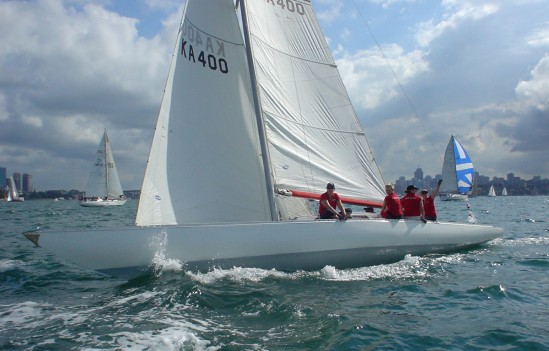
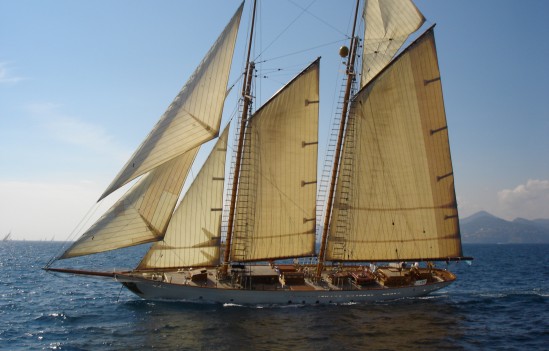
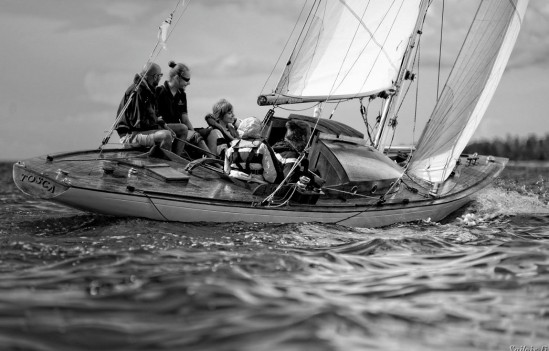



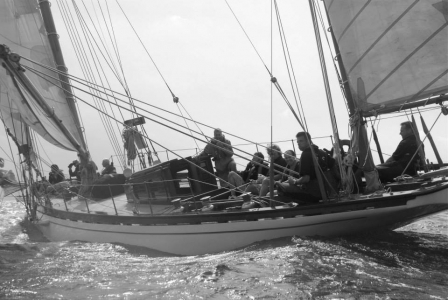
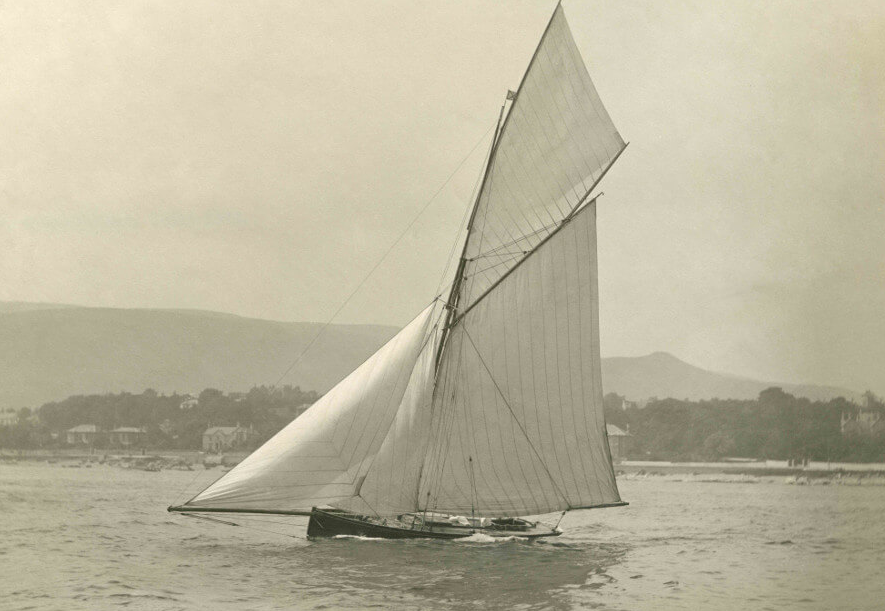
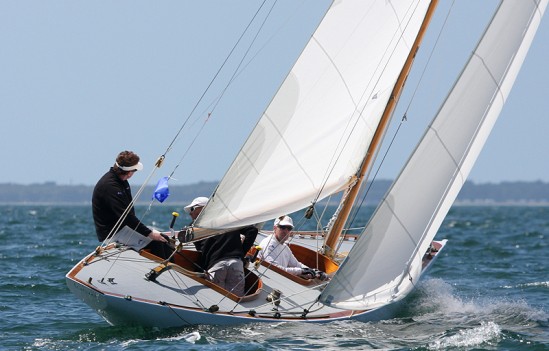

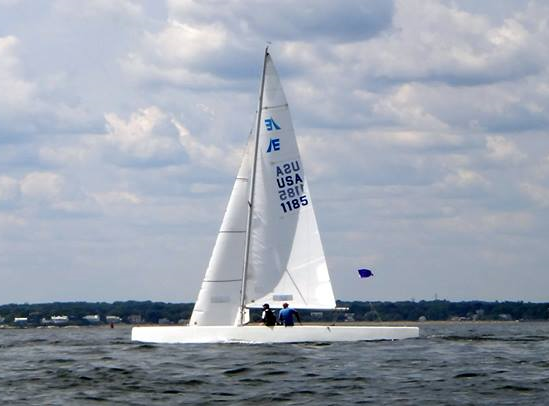

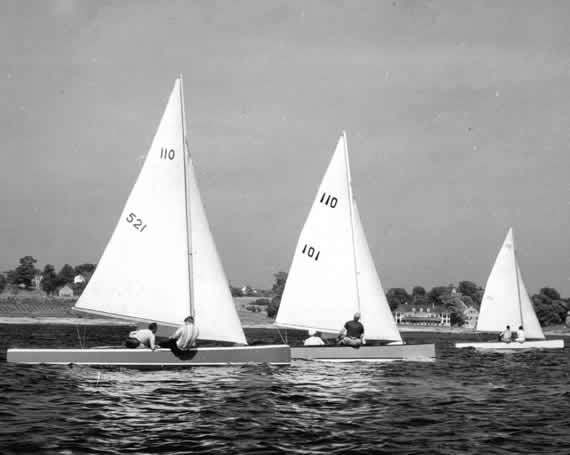
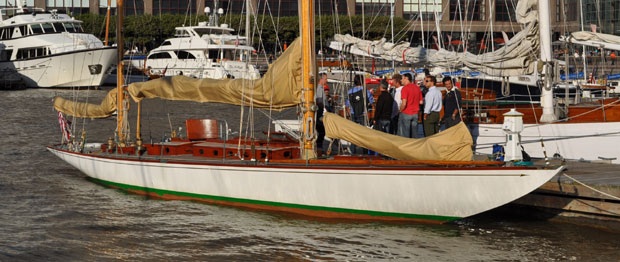
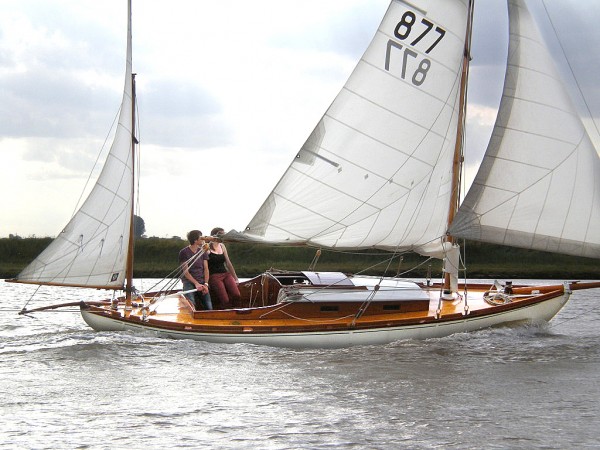
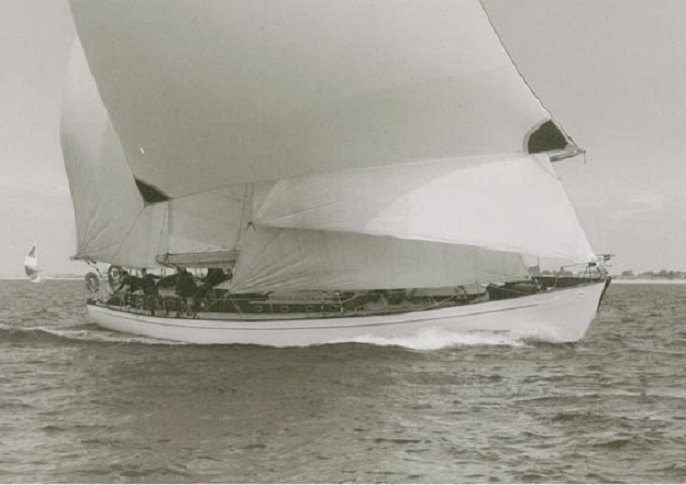
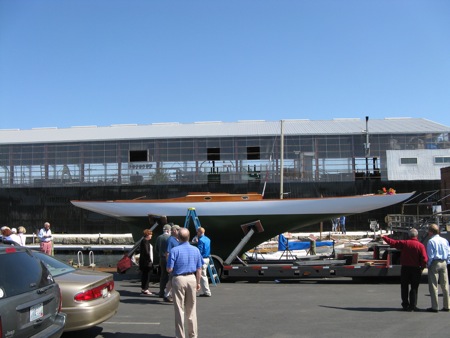
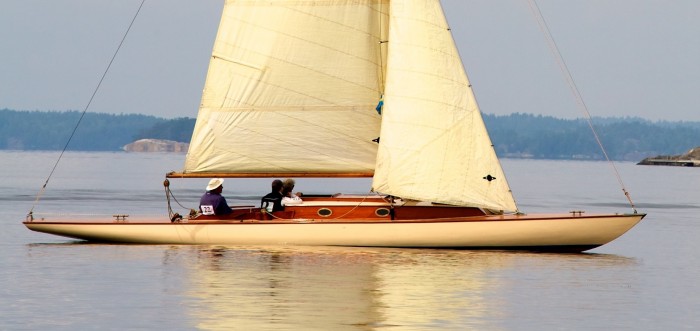
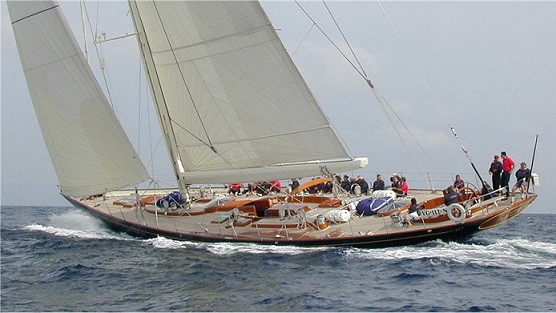

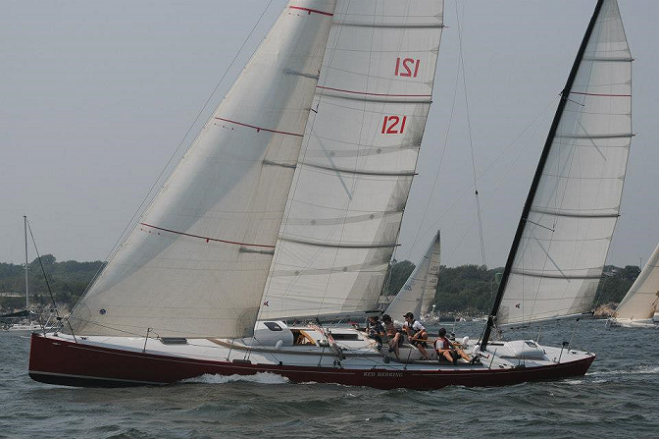
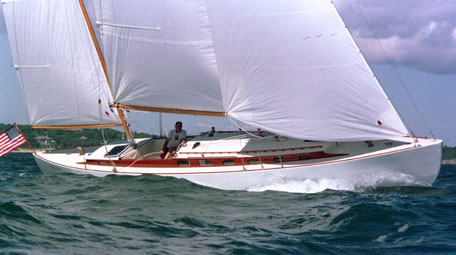
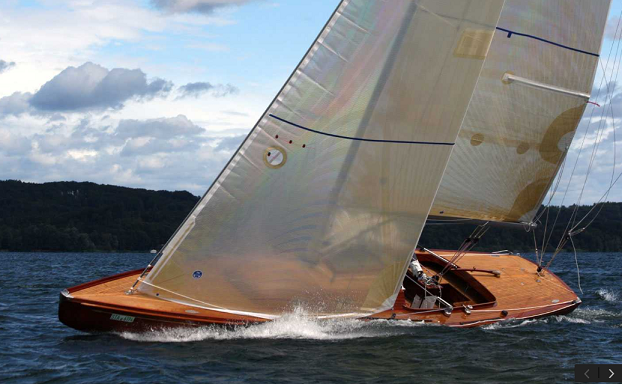
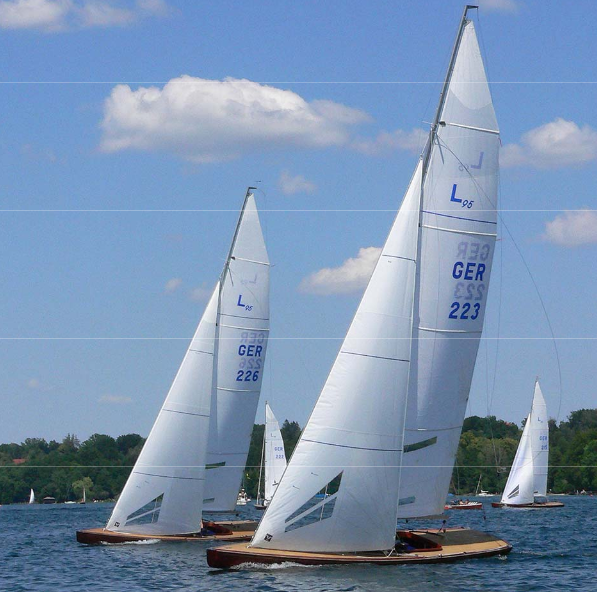
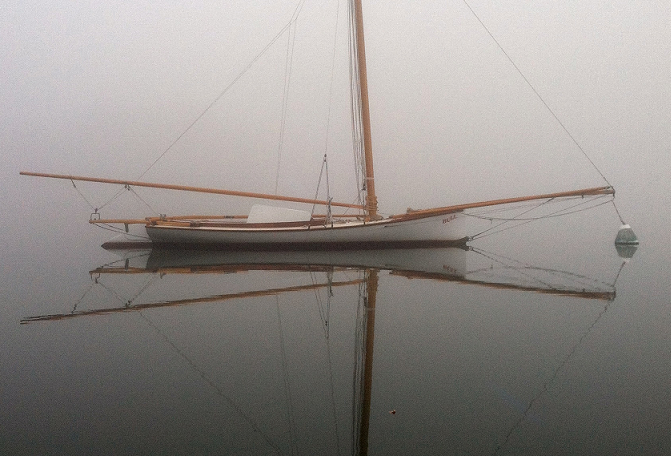
Hi, Crewed on ‘Escapde’ in, ’83. Where is she now, and what is her status ? Thanks, Bob
Bob…we just updated our report on Escapade, we have great admiration for this yacht, having raced against her in many OHC Races. She was the boat to beat, having won the OHC race twice, back when the race committee penalized yachts for winning, so as not to have repeat winners. A great yacht that deserves a new owner that values her past historic, significant role in Yachting.